


Soybean Staff
Ben Steyer Chief Executive Officer bsteyer@michigansoybean.org
Volume 17 - Issue 1




Soybean Staff
Ben Steyer Chief Executive Officer bsteyer@michigansoybean.org
Volume 17 - Issue 1
Mark Seamon Research Director mseamon@michigansoybean.org
Sonja Lapak, Editor Communication Director slapak@michigansoybean.org
Katlin Fusilier Outreach Specialist kfusilier@michigansoybean.org
Hanna Campbell Demand Specialist hcampbell@michigansoybean.org
Anna Skelly Accounting & Compliance Specialist askelly@michigansoybean.org
Claire Dewey Administrative & Marketing Coordinator cdewey@michigansoybean.org
Michigan Soybean Association 3055 W M-21 St. Johns, MI 48879 Phone: 989.652.3294 soyinfo@michigansoybean.org
Ad Sales
Sonja Lapak slapak@michigansoybean.org
J.L. Farmakis Inc. - National Phone: 203.834.8832 bill@jlfarmakis.com
Copyright 2023 by Michigan Soybean Association; all rights reserved.
Magazine Circulation: 18,000 Michigan Soybean News is published quarterly.
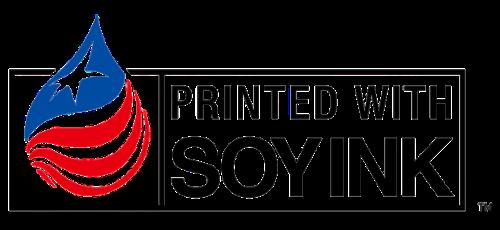

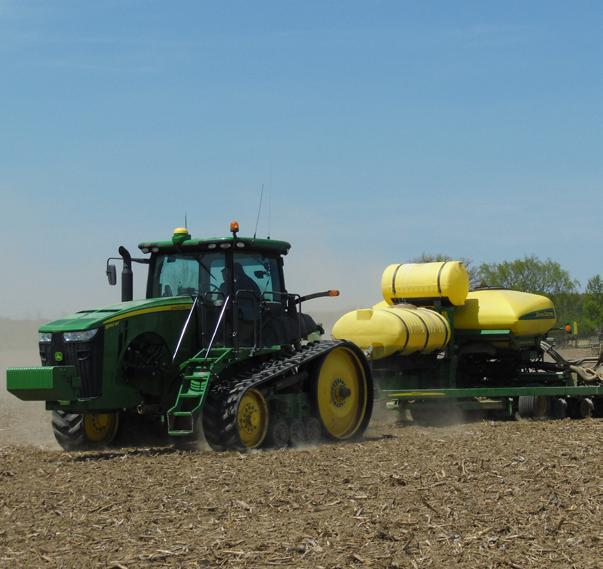
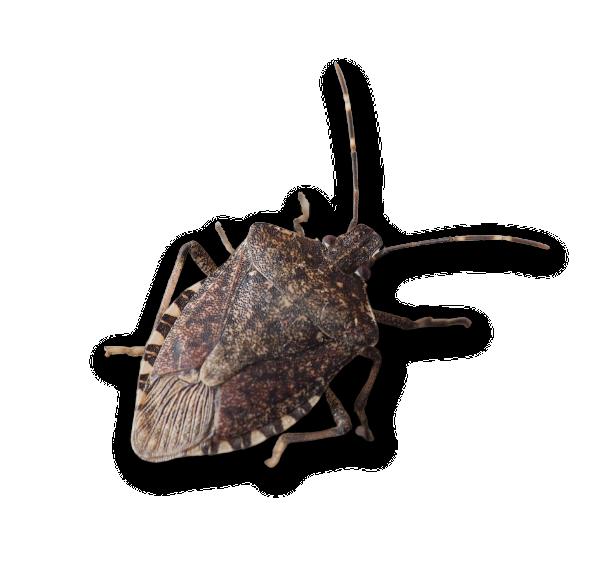
Disclaimer:
Advertisements within this publication contain the opinions and information of the advertisers and do not necessarily reflect the opinions or views of the Michigan Soybean Association or affiliated groups. The United Soybean Board/soybean checkoff neither recommends nor discourages the implementation of any advice contained herein, and is not liable for the use or misuse of the information provided. Michigan Soybean Association Mission: To improve and advocate for the Michigan soybean industry.

Michigan Soybean Association
Larry Phelps, Vicksburg
Jay Williams, Waldron
Tom Woelmer, Monroe
Karen Warner, Yale
Allison Morse, Birch Run
PJ Feldpausch, St. Johns
Matthew Wila, Blanchard
Rob Howland, Brown City
Robert Wasmiller, Burt
Michigan Soybean Committee
Sara Trattles, Colon
Pete Crawford, Dansville
Nathan McCalla, Ann Arbor
Scott Wilson, Lexington
John Burk, Bay City
Mark Senk, Owosso
Ryan Drozd, Allegan
American Soybean Association
Heather Feuerstein, Belding
Janna Fritz, Bad Axe
United Soybean Board
Laurie Isley, Palmyra
Dennis Gardner, Croswell
Carla Schultz, Mayville
North Central Soybean Research Program
Steve Koeman, Hamilton
US Soybean Export Council
Dave Williams, Elsie
Clean Fuels Alliance America
Matt Stutzman, Adrian
Soy Aquaculture Alliance
Alan Moore, Bannister
Soy Transportation Coalition
Dan Rajzer, Decatur
World Initiative for Soy in Human Health
Doug Darling, Maybee
Specialty Soya & Grains Alliance
Steve Peach, Plymouth
US Meat Export Federation
Brian Pridgeon, Montgomery
Farm Produce Insurance Fund
Jason Haag, Unionville
Tell us about yourself, your farm and your family.
I graduated from Chesaning High School and attended Delta College. I live in Burt, MI with my beautiful wife Erin, who I married in the summer of 2020. We have two wonderful daughters, Keira who is 3 and McKenzie who is seven months old. We grow soybeans, dry beans, corn and sugar beets across our 400 acre farm. I also work alongside my father, Joe, on his farm. Together we share ideas and strategies to be economically sound and sustainable, treating both individual operations as one large family farm whenever possible.
Favorite MSA board experience?
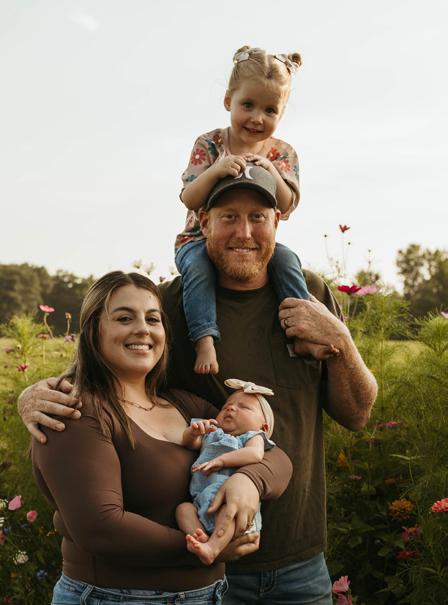
I was on the outreach subcommittee during this first year on the board and I very much enjoyed reading and scoring the college scholarship applications. I found it very reassuring that so many promising young students plan to continue their educations and start careers in the agriculture industry.
Planting or harvest?
I enjoy both seasons for many reasons! But if I had to choose, I prefer planting time. The weather is usually better and I enjoy the clean slate and optimism the beginning of the year has. We like to make sure all of our controllable details start off the very best way possible, before the uncontrollables start breaking our heart.
Off-farm hobbies?
Being a farmer can be very demanding so I enjoy spending as much time as I possibly can with my wife and children. Making memories with them riding our side by side around and going to the local park. I look forward to teaching them to snowmobile in the winters as I did with my family when I was younger.
Red or Green?
We’ve had red equipment in the past and we like to show off our antique Farmalls, but we are a John Deere Green family. Do you have a farm dog?
We have a very spoiled, hard working farm dog named June. June is a seven year old German Shepherd and Labrador mix. She can be found digging up sugar beets from the ground and eating them entirely. She also enjoys helping dump grain from the semis and chasing tractors from one end of the field to the other.
Favorite tractor snacks?
Any and all candy! Snickers bars, bags of M&Ms and Skittles.


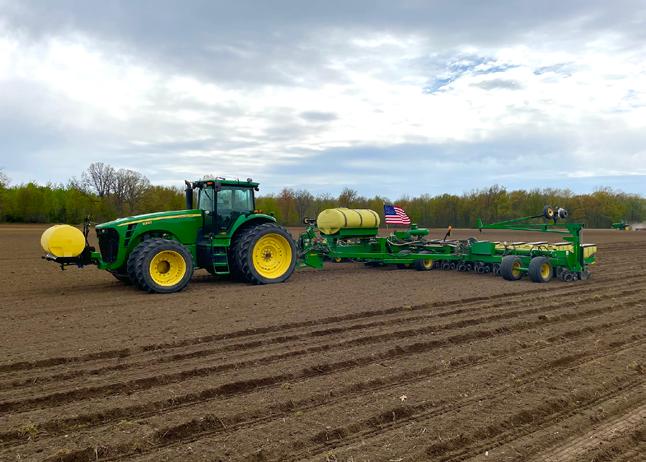

It’s been six months since I joined the MSC & MSA team, and over these past few months I have learned to appreciate all the hard work that our farming community does. For the past 18 years my family and I have lived in a small rural area of southwest Michigan where we can watch the harvest season come and go from our back porch. I will admit, prior to this job, I had no extensive knowledge of farming; I was just a bystander. I merely knew that our field would either be corn or soybeans and that it was on a rotation every year.
During my first week, Mark Seamon asked me if I knew the reproductive stages of soybeans. I'm sure I had this look on my face like I had just failed my first test. Mark’s enthusiasm and passion for soybeans struck me that I had a lot of learning to do.
The next day I asked my son if he knew the actual growth stages of soybeans, since he loves playing Farmer Simulator either on his tablet or Xbox, and of course like any 12-year-old he was like "no, but I’m planting right now". So he and I sat down and looked up on YouTube the stages of soybeans and discussed where he was at in his game, how much his price per bushel was, etc.
Fast forward several weeks and I was at the school for parent teacher conferences and was speaking with our son’s social studies teacher. He was impressed and caught off guard that during my son’s downtime he was reading yield reports and sharing with his teacher all the cool things he was reading about happening in the farming community. It was a pure proud mom moment - I love that his interest in agriculture has grown alongside mine.
Last summer our son had a four-wheeler accident and did some damage to one of our small barns. Since then, he has proposed multiple options for what we could turn this barn into while fixing it up. Of the top choices is a greenhouse so he can grow all the strawberries his younger sisters can eat as well as their favorite vegetables. He is also still working on convincing dad to let him plant some fruit trees, and I have to remind him it's one project and step at a time.
I am a true believer that everything happens for a reason. I am thankful for this opportunity to serve our farmers in my new role here at MSC & MSA while continuing to encourage my son to become the best farmer he can be once he grows up.

Anna Skelly Accounting & Compliance Specialist askelly@michigansoybean.org
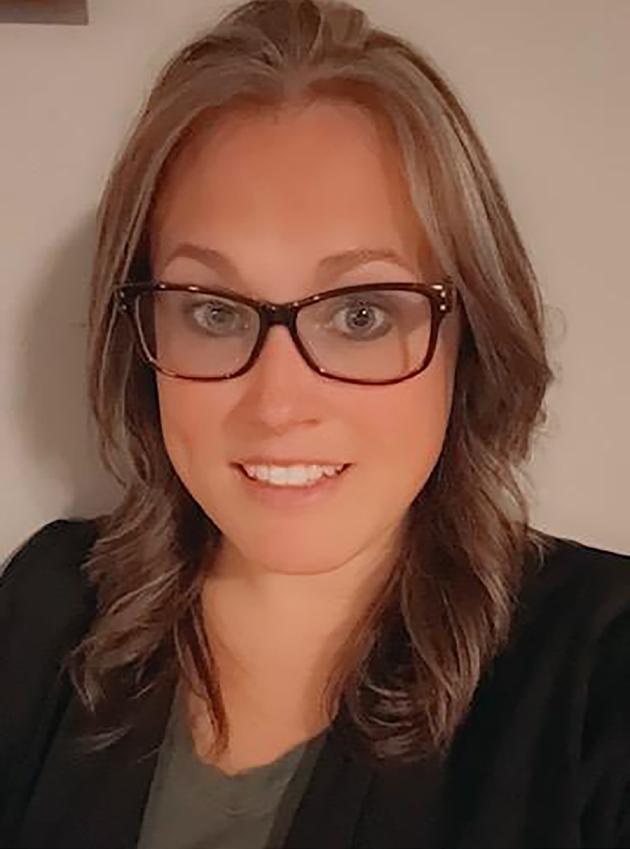
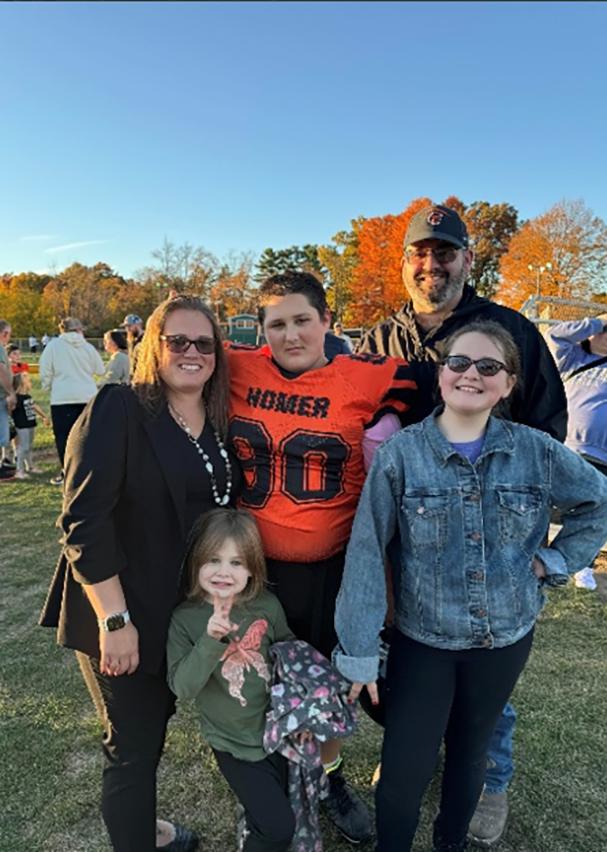
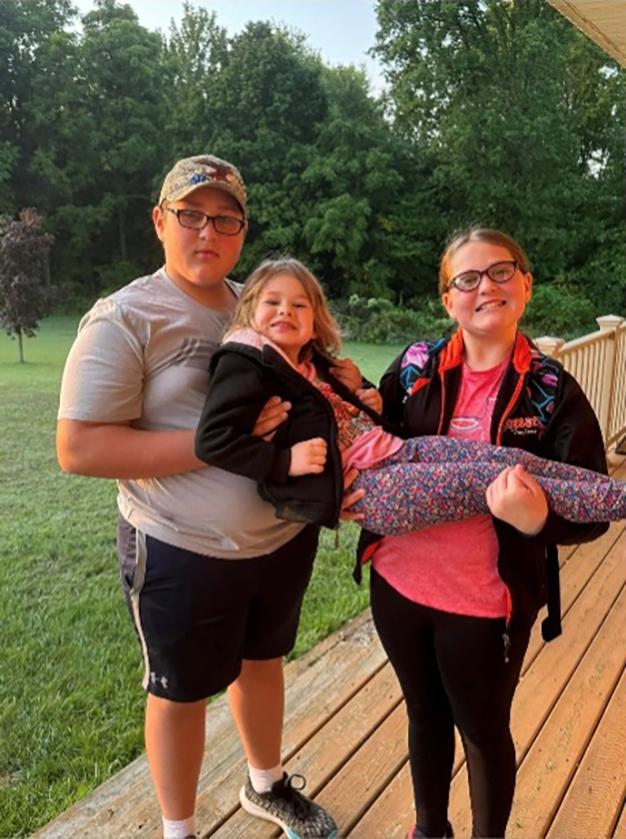


The winners of the 2024 Michigan Soybean Association(MSA) yield contest were announced at the end of 2024. The winners from each category were celebrated at the MSA Annual Meeting and during the Great Lakes Crop Summit.
In 2024 there were over 130 entries from soybean farmers across the state of Michigan. MSA would like to thank all of the sponsors of this year’s contest. Without their support this contest would not be possible. The 2024 contest was sponsored by the Michigan Soybean Committee, AgriGold, Asgrow, Beck’s, Channel, DF Seeds, Dairyland Seed, Dyna-Gro, Golden Harvest, Pioneer, Renk, Xitavo and ZFS.

Additional information about the contest and all harvested entry data can be found at misoy.org/ yield-contest
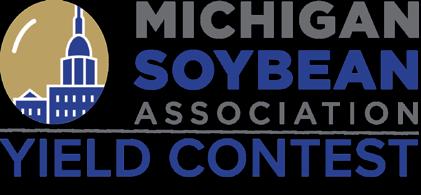






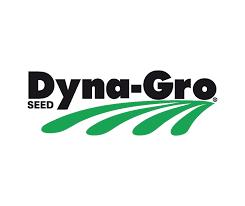






Congratulations to this year's winners and thank you to all that participated! Details about the 2025 contest will be posted on our website, shared on social media and included in future editions of the Michigan Soybean News Magazine.
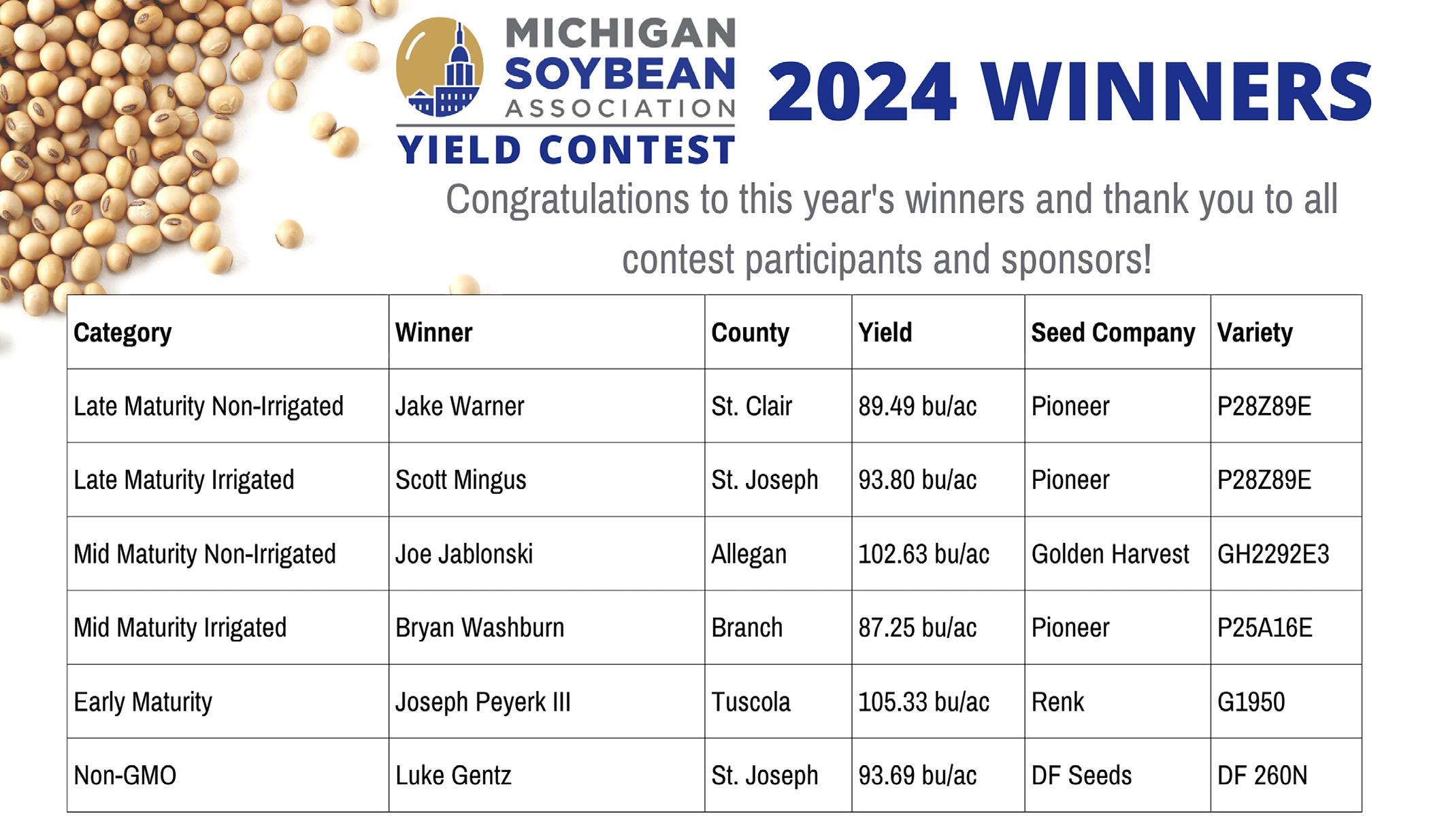

The Michigan Soybean Association announced the results of their director elections during their 51 st Annual Meeting of Members held during the Great Lakes Crop Summit at the end of January. Districts 3 and 6 as well as one At-Large seat were up for election this year.
In District 3, Tom Woelmer of Monroe was re-elected for a second term. In District 6, PJ Feldpausch of St. Johns was re-elected to a second term. Rob Howland of Brown City was also re-elected to serve another term as an At-Large director.
Following the Annual Meeting of Members, the MSA board met to elect the 2025 Executive Committee.
• President – Larry Phelps of Vicksburg
• Vice President – Tom Woelmer of Monroe
• Treasurer – Allison Thiel of Birch Run
• Secretary – PJ Feldpausch of St. Johns
Congratulations to Tom, PJ and Rob on being reelected to the board! We also want to congratulate the Executive Committee and look forward to their leadership in 2025!
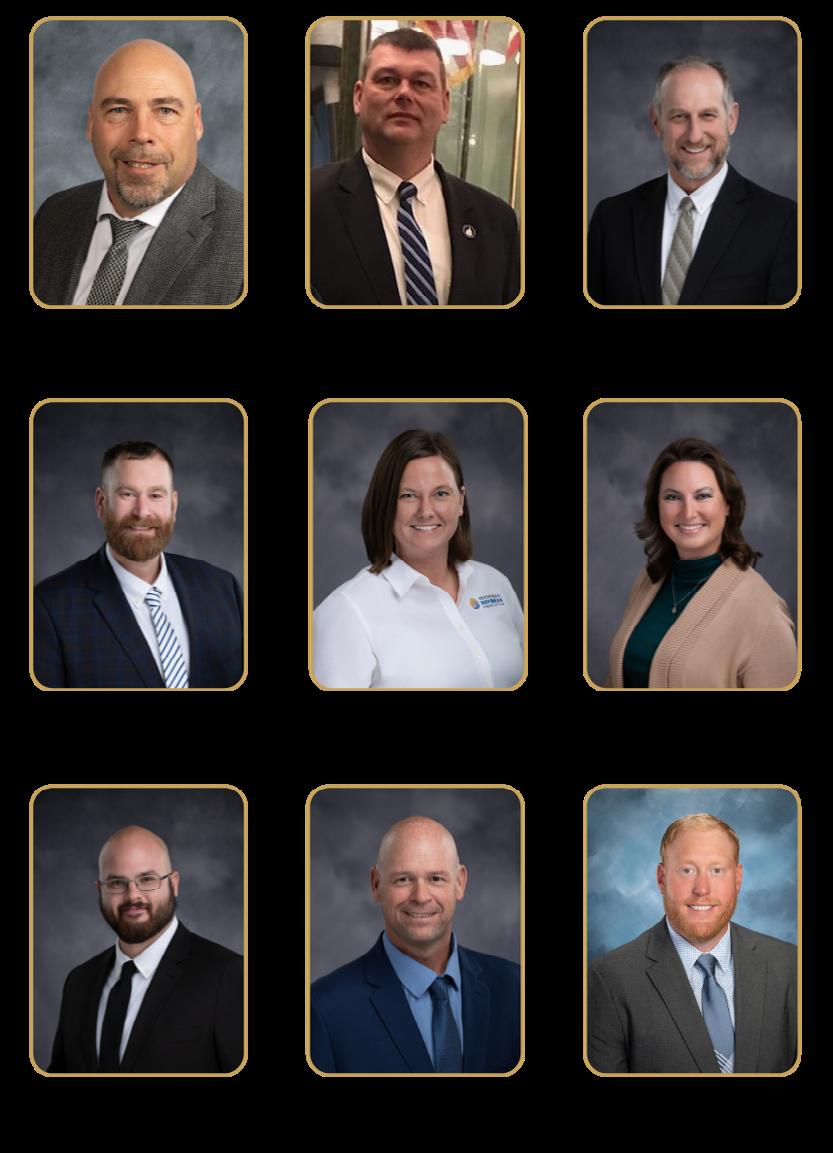
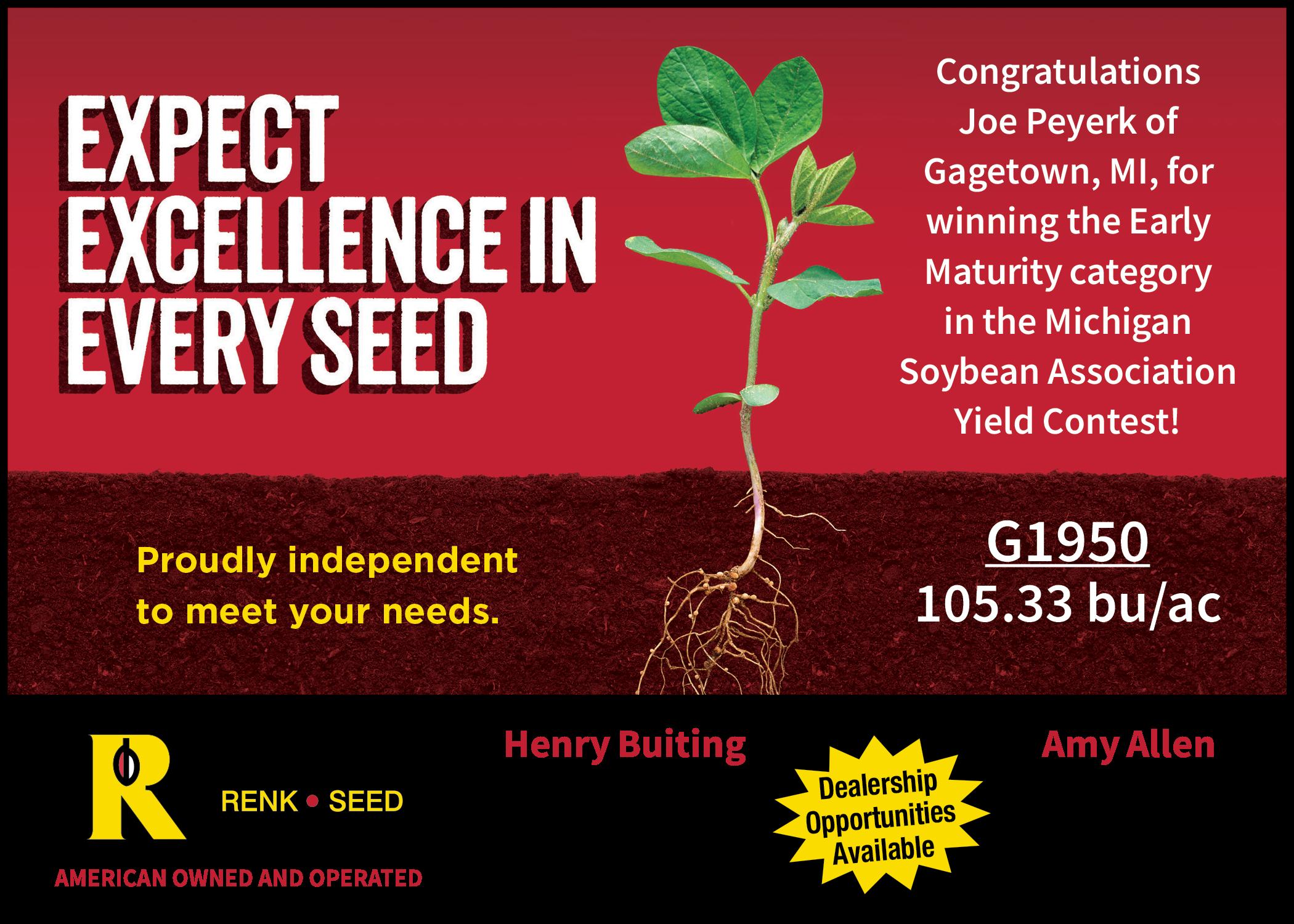

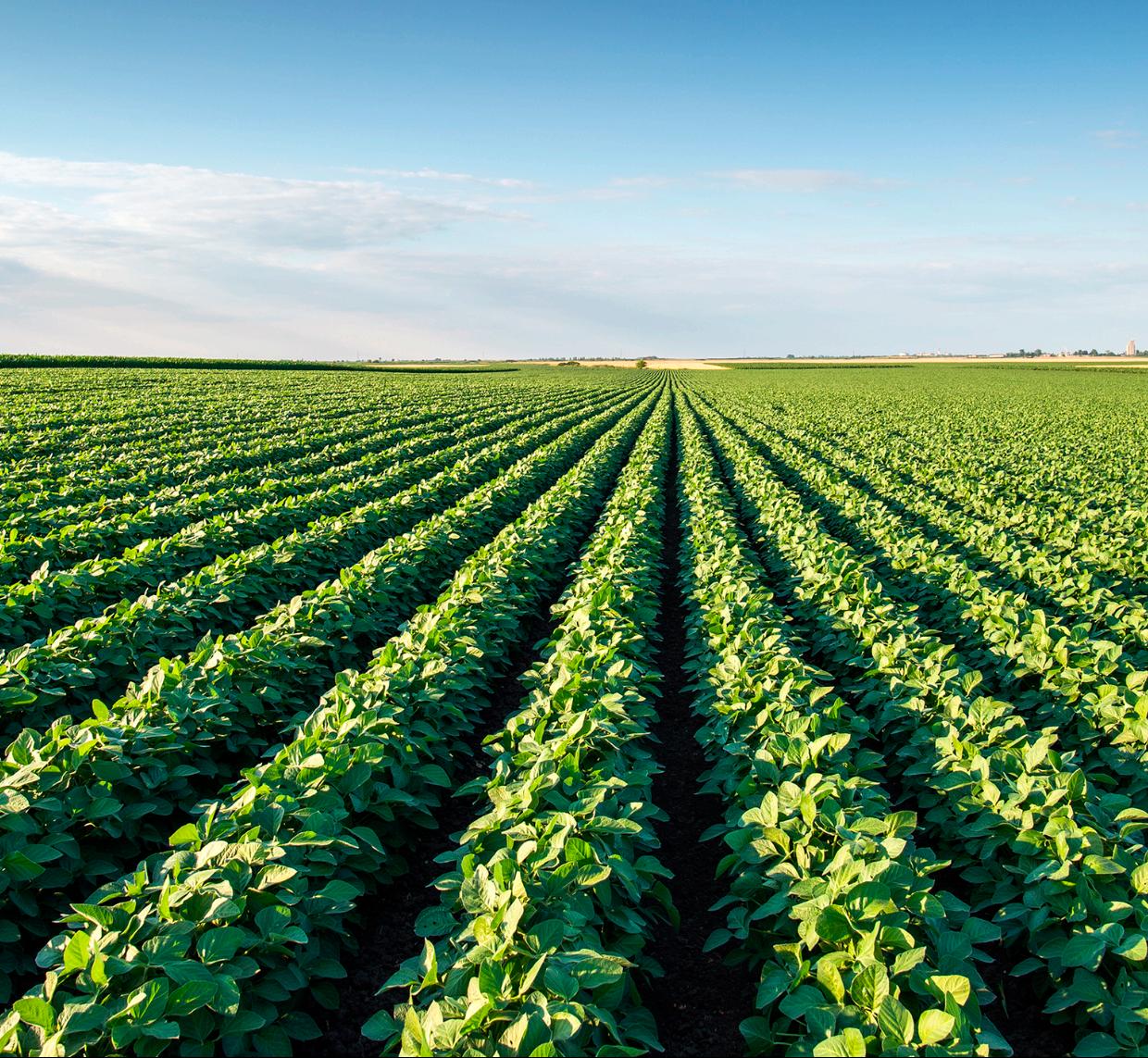

NEW MEMBERS:
Kyle Kelley, Sturgis
Todd Otto, New Lothrop
Frank Rochowiak, Milan
Steve Koroleski, Kinde
Keith DuRussel, Reese
James Meier, Bay City
Andrew Gabriel, Maybee
Mason Coles, Cassopolis
Adam Smetka, Britton
RENEWING MEMBERS:
Karen Warner, Yale
Chris Kropf, Lowell
Dave Dyer, Richland
Ron Balowski, Climax
David Williams, Elsie
Douglas Long, Clayton
Gary Girbach, Saline
M. Dean Haubenstricker, Frankenmuth
Robert Rosenow, Whittemore
Peter Crawford, Dansville
PJ Feldpausch, St. Johns
Rob Howland, Brown City

Doug Lagos, Cass City
David Conklin, Corunna
Dan Wonders, Pittsford
Dan Rajzer, Decatur
Scott Bartz, Dorr
Clay Ottoni, Waterford
Harold Anderson, Fowlerville
Larry Palmreuter, Frankenmuth
James Patrick LaPorte, Cassopolis
Rex Ulrich, Sand Creek
George McCalla, Milan
David Brink, Holland
Ted Wilk, Alma
Abraham Nemcik, Saint Johns
Frank Marcello, Hemlock
Robert Elston, Melvin
John Sulkowski, Wales
David McConnachie, Deckerville
Ryan Loew, Byron Center
Ronald Gerstenberger, Sandusky
Mike Jasper, Sawyer
Kendall English, Breckenridge
Cade Klein, Marcellus
Jamie Robson, Milan
Mary Kelpinski, East Lansing
Brian Frederick, Hemlock
Brian Bellville, Prescott
James Isley, Palmyra
Gerald Opificius, Mussey
Paul Taylor, Ottawa Lake
Lyndon Uphaus, Manchester
Phil Gordon, Saline
William Hayward, Hillsdale
John Brendel, North Branch
Doug Suwyn, Caledonia
Theresa Sisung, Lansing
Larry LaPointe, Temperance
Herb Zahm, Marne
Donald Johnson, Camden
Robert Richardson, Vicksburg
Nathan Peters, Riley
Tracy Ostrander, Lansing
Stephen-Wayne Schlagel, Turner
Larry McCrackin, Carson City
T Mark Hinterman, Durand
Josh Bieber, Dorr
Todd Bieber, Dorr
Richard Jacobs, New Lothrop


First Name:_____________________________
Last Name:_____________________________
Address:_______________________________
City/State/Zip:___________________________
Phone:_________________________________
Cell Phone:_____________________________
Email:_________________________________
1-yr: $75 3-yr: $190
Young Farmer (18-24): $20
Non-Farmer Individual: $100
Payment Amount & Method:
Check (Payable to MSA) or Credit Card
Credit Card Type:_____ Expiration Date:______
Credit Card #:_________________ CVV:______
Signature:_______________________________
Date of Birth:__________________
Number of Soybean Acres:_______
Total Farm Acres:______________
Occupation (circle one):
Farmer Retired Other
• Dues are not tax deductible as a charitable contribution for federal tax purposes, but may be deductible as a business expense.
• 18% of member dues are allocated to lobbying activities and are not deductible.
Mail application with payment to: Michigan Soybean Association 3055 W M-21, St. Johns, MI 48879
Join online:
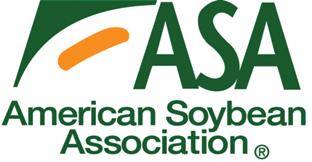

Paying the soybean checkoff does not make you an MSA member. Checkoff dollars cannot be used for lobbying. Your membership is critical to our efforts on behalf of Michigan soybean farmers!
For more information on member benefits, visit www.misoy.org/member-benefits/. Member benefits include:
• Scholarship opportunities for your children and grandchildren
• Preferred vehicle pricing opportunities
• Cabela’s gift card purchase discount
• Discounted registration to Commodity Classic
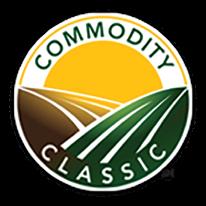






• Annual $75 seed coupon for renewing members to use with our partnering seed companies
• The MOST IMPORTANT MSA member benefit: Having a voice in Lansing and Washington, D.C.!
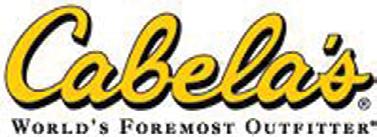

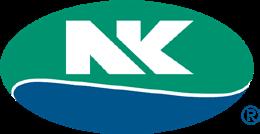

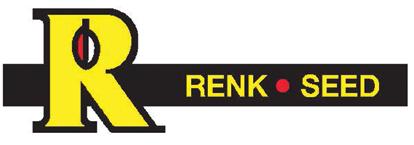
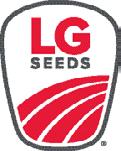





In early January, Michigan farmers Larry Phelps (Kalamazoo County), Tom Woelmer (Monroe County) and Logan Maher (Sanilac County) were accompanied by Michigan Soybean CEO Ben Steyer to the 2025 Soybean Leadership Academy in Orlando, Florida. This annual event provides farmers from across the country with valuable insights and networking opportunities. The event featured a series of sessions led by industry experts focusing on leadership, collaboration and the future of agriculture.
The group was greeted during the opening session with welcome remarks from ASA President, Caleb Ragland. Jennifer Coleman, Director of Communications at The Directions Group (formerly Aimpoint Research), then delivered a thoughtprovoking session on "The Future of Agriculture and Farmers of the Future," highlighting the evolving landscape of the agricultural industry. One key takeaway from this presentation was that the demand for protein in human diets is expected to double by 2050.
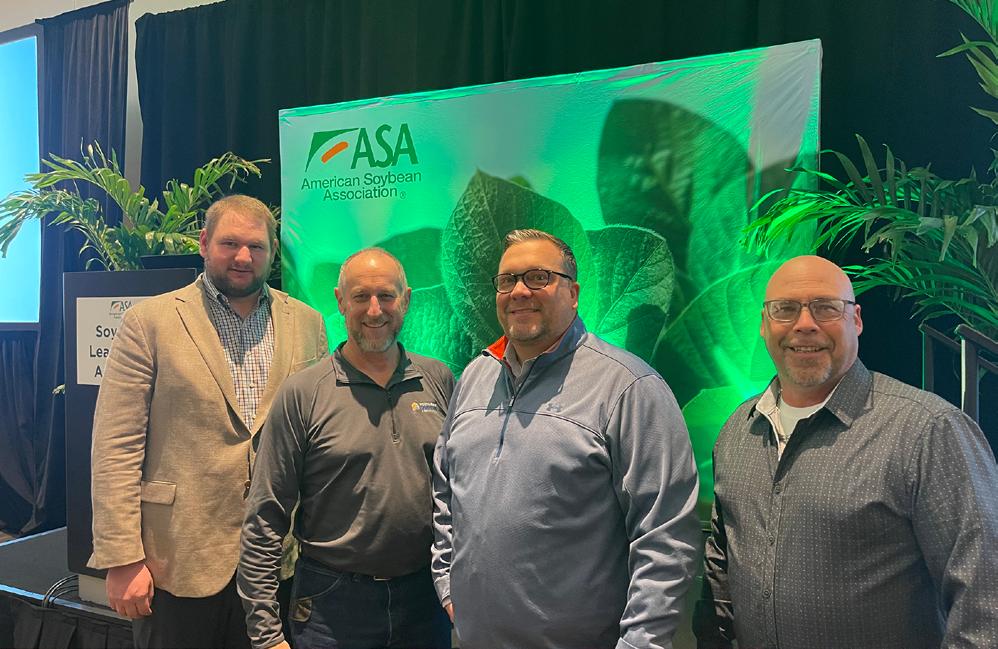
The meeting continued with breakout sessions tailored to different leadership roles. The sessions included presentations from Karin Hurt, CEO of Let’s Grow Leaders, who spoke on "Courageous Cultures: Unleashing Ideas and Fostering Collaboration." Ensuring that boards are aligned and working in unison is important to all board-driven organizations. To cover this topic, Elisa Pratt, CEO of Brewer Pratt Solutions, presented on "Executive Leadership Legacy: Strategies for Board Success". There were also organizational and industry updates provided by Stephen Censky, CEO of ASA, and Lucas Lentsch, CEO of USB.
In addition to her first presentation, Karin Hurt also gave a presentation entitled "Can We Talk for Real? Practical Tools and Techniques for Courageous Conversations". This was a very insightful general session that aligned perfectly with the leadership academy’s theme, Building the Future – Courageous Leadership. Hurt focused on how impactful improved communication can be for an organization and provided strategies on how to gain more clarity from conversations.
The event also provided time for a Soybean Industry Grower Leader Panel moderated by Stephen Censky, featuring prominent industry leaders such as ASA President Caleb Ragland, USB Chair Phillip Good, US Soybean Export Council (USSEC) Chair Lance Rezac, and World Initiatives for Soy in Human Health (WISHH) Secretary Scott Gaffner. Each leader provided updates from their respective organizations during this enlightening and conversational general session. Each farmer highlighted the unique successes of their soy-organizations and provided valuable insight about their priorities as we start 2025.
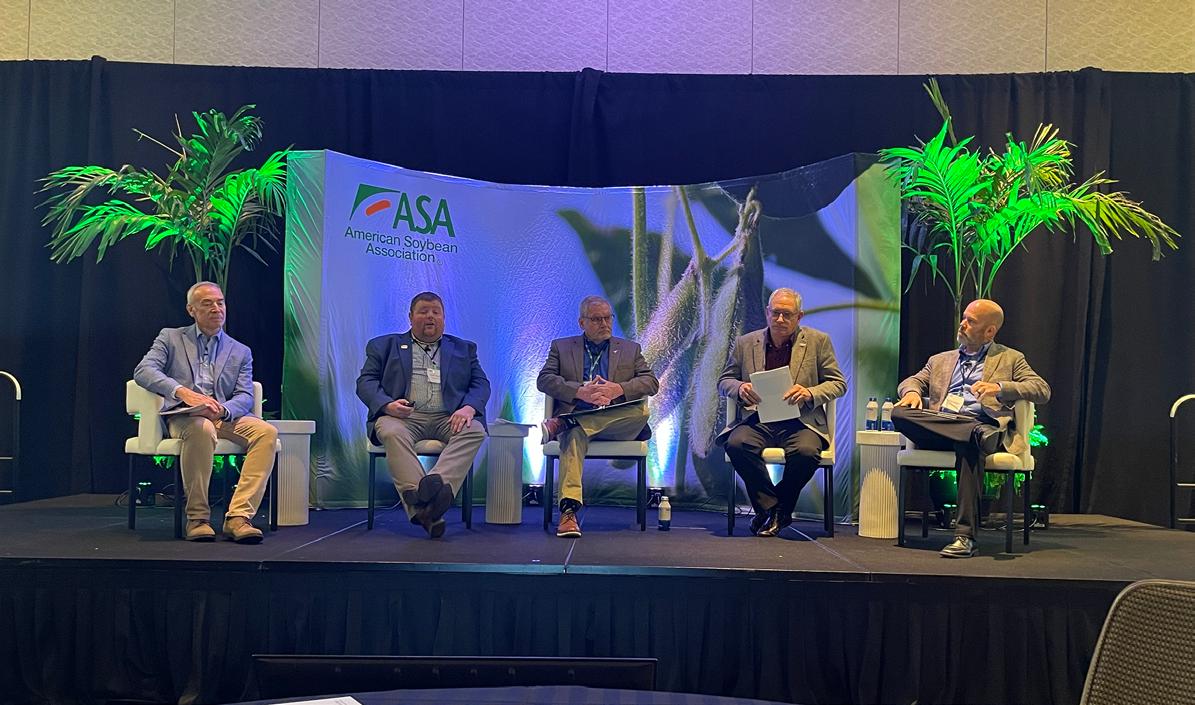
The 2025 Soybean Leadership Academy provided Michigan soybean farmers with a comprehensive and enriching experience, equipping them with the knowledge and tools to lead and navigate the future of agriculture.

Jason Wadaga, Vice-President of Government Relations, Kindsvatter, Dalling & Associates
The start of a new legislative session has brought a slew of priority legislation, funding proposals and new committee assignments in the Michigan House of Representatives.
Both the House and Senate have made it a priority to adopt changes to the ESTA.
House Bill 4002 (Rep. DeBoyer) would make changes to the ESTA that would take effect on February 21 st following a Michigan Supreme Court decision this summer. That legislation passed the full House of Representatives in a bi-partisan fashion in early February.
The ESTA would require that employers of any size provide 72 hours of paid medical leave each year. On top of that, it would also implement processes on accumulating paid sick time and allow for a “private right of action” against employers that don’t adhere to the act.
House Bill 4002 would make the following changes to ESTA:
• Exemptions for seasonal and part-time employees
• Exempt employers of 50 employees or less
• Allow earned sick time to be combined with other PTO benefits
• Limit the carryover to 72 hours annually
• Allow employers to front load leave time as opposed to having to calculate accrued sick time
• Remove the 3 day “no-call, no-show” provision.
(The soon to be adopted law would allow employees to take three consecutive days off without documentation and not be disciplined)
• Eliminate the rebuttal presumption against employers
• Eliminate the private right of action against employers
MSA joined many other agriculture groups in support of House Bill 4002 in the Michigan House of Representatives.
Meanwhile, the Michigan Senate has introduced Senate Bill 15 (Sen. Singh) to make amendments to the act. The Senate has held hearings on the legislation and negotiations are ongoing with the House of Representatives.
In early February, Speaker of the House, Rep.
Matt Hall announced that he had appointed Rep. Jerry Neyer (R-Mt. Pleasant) as the new chairman of the House Agriculture Committee in Michigan.
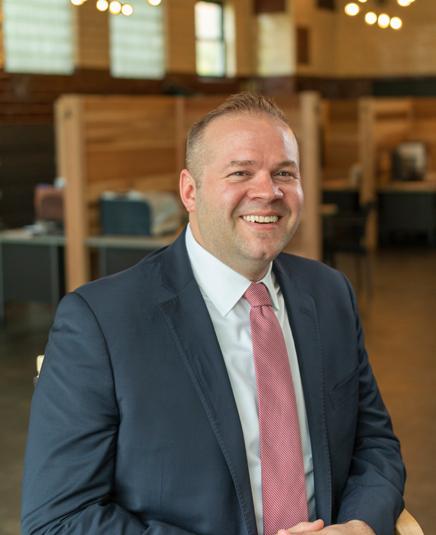
Neyer comes with decades of experience in agriculture, having been a dairy farmer for 30 years and serving on the Isabella County Farm Bureau for 20 years. He has also been a frequent attendee at MSA board meetings and attended several MSA functions. We are excited to begin working with Rep. Neyer in his new role.
Gov. Whitmer’s budget team presented their Fiscal Year 2025-26 budget proposal in early February. The proposed budget is $83.5 billion, a 2.7 percent increase from last year’s budget.
Some of the highlights of the budget proposal include:
• A $392 per-pupil increase for in the K-12 budget for all Michigan students
• Raising the tipping fee on solid waste from 36 cents per ton to $5.00
• A tax for vaping products at a rate of 32 percent of the wholesale price
• A $50 million payment to the “Rainy Day” fund
• $240.9 million in raises for state employees
• $211 million for road improvements
• Increasing compensation for corrections officers
• Hiring 120 new Michigan State Police Troopers
The several month-long negotiation between the Governor’s office, House and Senate will now begin before the final adoption of the budget.
In mid-February, Governor Whitmer announced her roughly $3 billion long-term road funding plan. While in the infant stages, the proposal would center around three major funding sources including:
• $1.6 billion from new taxes to large corporations
• $500 million from government efficiency
• $470 million from a new wholesale marijuana tax


Through the Michigan Soybean Committee's partnership with The Henry Ford Museum, we have had the privilege to connect and work with Deb Reid, the Curator of Agriculture and the Environment at the museum.
Deb recently reached out to us with an inquiry for farmers we may know or be connected to:
"I am working on an application to the American Society of Agricultural and Biological Engineers (ASABE) for the TR70 combine. 2025 is that machine's 50 th anniversary. Are there any farmers in Michigan Soybean Committee circles willing to share their histories with the machine? Do any try to keep their TR70 operating? I would love to talk to them."

The TR70 was a self-propelled combine manufactured by Sperry-New Holland in 1975. It was the first rotary combine which used centrifugal force to separate grain. Other manufacturers soon followed with the adoption of this technology. Though the combine itself was made by the New Holland Division of the Sperry Rand Corporation in New Holland, Pennsylvania, the Ford Motor Company in Dearborn made the engine. This combine is currently on exhibit in The Henry Ford Museum's Agriculture and the Environment section.
If you or someone you know still has one of these combines or if you have any stories of utilizing in the past, we would love to connect you with Deb and her team at The Henry Ford. Please email Sonja Lapak at slapak@michigansoybean.org if you'd like to share.



The Michigan soybean checkoff is assessed at the rate of one-half of one percent (.005) of the net market value of soybeans sold by the producer to the first purchaser.
Checkoff assessments collected by Michigan first purchasers must be remitted to the Michigan Soybean Committee. The funds are used for production research, market development and outreach efforts on behalf of Michigan’s 12,000+ soybean farmers.
Thank you to the first purchasers who collect the checkoff each month! Their cooperation is a critical step in helping ensure checkoff funds are utilized for the collective benefit of Michigan soybean farmers.
Acres Cooperative
ADM Grain Co.
American Soy Products Inc.
Armada Grain Co.
Battle Creek Farm Bureau Assn.
Bierlein Seed Inc.
Caledonia Farmers Elevator
Cargill
Community Mills Inc.
Cooperative Elevator Co.
Cremer Farm Center
DF Seeds, LLC
Esper Grain, LLC
Farmer's Coop Elevator
Farmer's Coop Grain Co - Kinde
Freeland Bean & Grain
Gallagher Farms
Great Lakes Grain and Transportation
Harrington Seeds Inc.
Harvest Mills Inc.

Hirschman Grain, LLC
Hoffman Ag Service, LTD
Hopkins Elevator
Ittner Bean & Grain Inc.
John Marion Inc.
Jorgensen Farm Elevator
Keystone Cooperative
Litchfield Grain Co.
Luckey Farmers, Inc.
M&W Seeds
MAC
Masserant's Feed & Grain
Mathews Elevator
Maybee Farmers Inc.
Millington Elevator & Supply
Moline Coop
Morning Star Grain, LLC
Musgrove Grain, LLC
Ottawa Lake Coop
Ovid Elevator Company
Penn Acres
Prattville Fertilizer & Grain, Inc.
Quality Roasting, LLC
Shaffer Farms
Springport Elevator, Inc.
Star of the West Milling Co.
StoneX
Stop Loss Trading, LLC
The Andersons
Turner Bean & Grain
Van Gilder Commodities, LLC
Vershum R & Sons Inc.
VHGC, Inc.
Vita Plus
Viterra US
Voyces Elevator Inc.
Waldron Grain & Fuel Co.
Westphalia Milling Co.
Zeeland Farm Services Inc.
ZFS Ithaca, LLC
Zmitko Farms

Fans at Michigan State University’s February 7 th hockey game vs. Michigan had the opportunity to learn about the power of soybeans and how they can “Score Big with Soy”. The Michigan Soybean Committee set up an interactive booth on the concourse of Munn Ice Arena, engaging with consumers about the many benefits of soy, from nutrition and sustainability to its role in animal feed and renewable products.

Hockey fans stopped by the booth to test their soybean knowledge with trivia and win fun soybean giveaways. Whether they were longtime supporters of agriculture or new to the world of soybeans, visitors walked away with a greater appreciation for this versatile crop and its impact on their daily
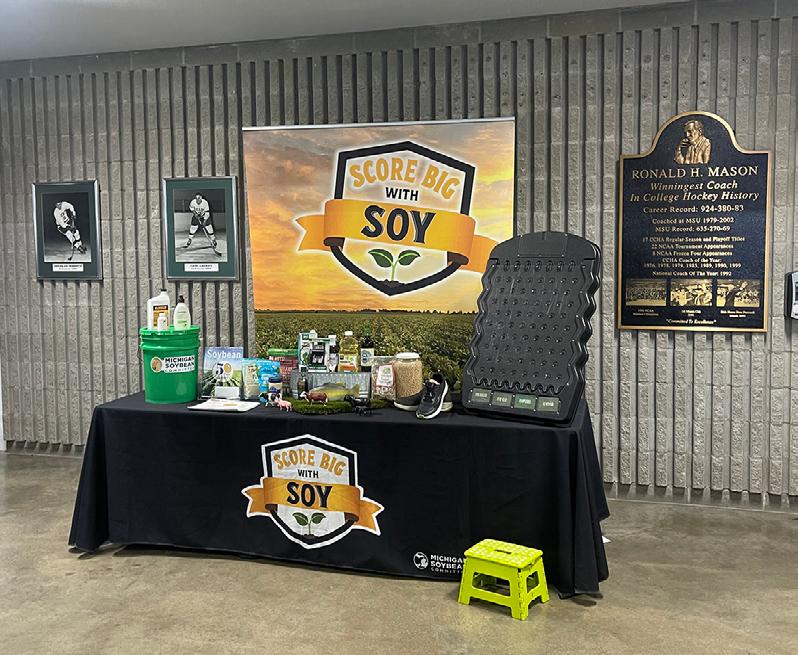
As we continue our increased consumer outreach efforts, we look forward to more exciting events that highlight the importance of soy. Whether at a football tailgate, basketball, baseball or hockey game, we’re always ready to share how consumers can “Score Big with Soy!”.
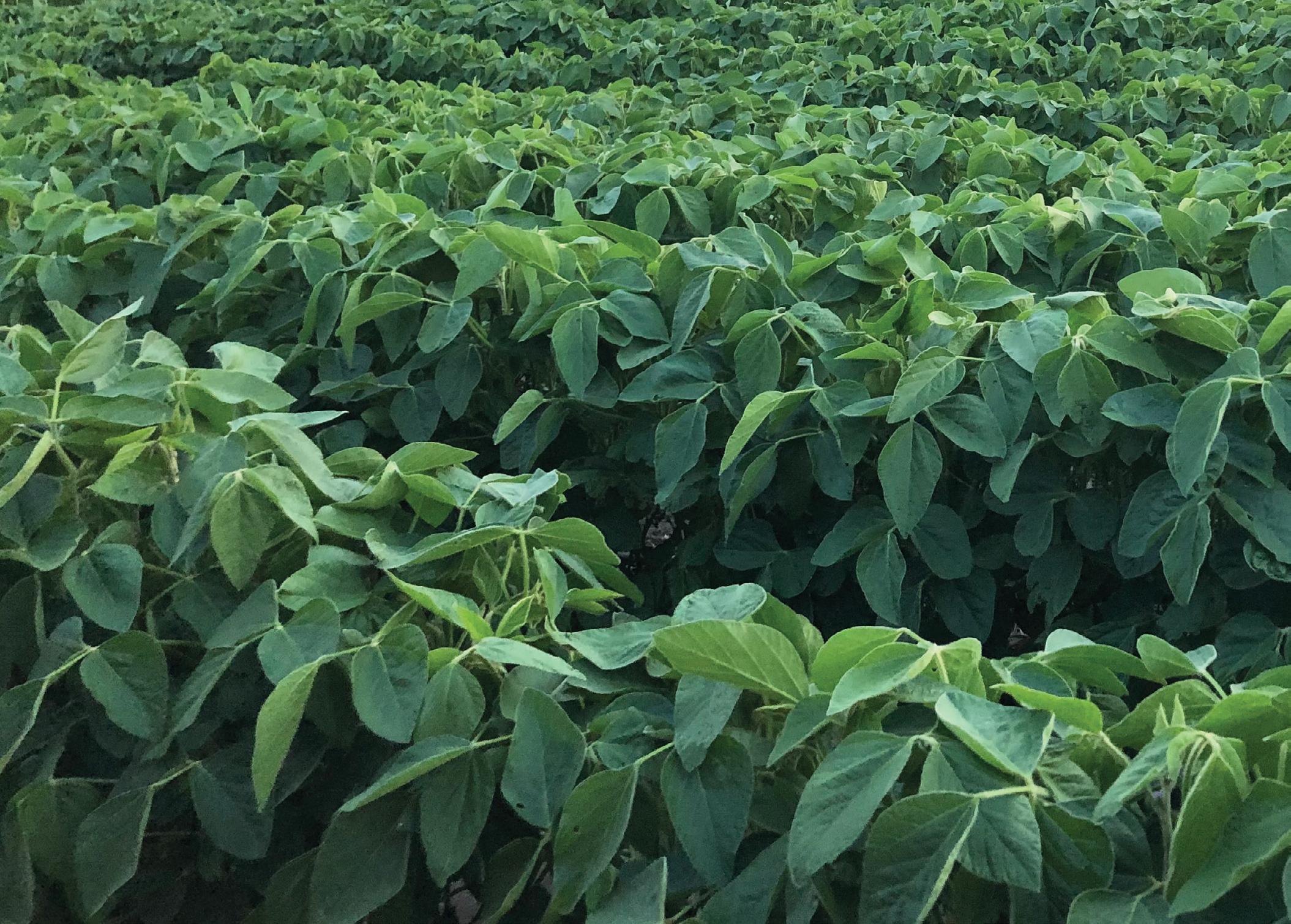

As part of an ongoing partnership with MSU Athletics, the Michigan Soybean Committee sponsored the Michigan State University men’s basketball game on January 15 th vs. Penn State. MSC staff hosted an interactive exhibit on the concourse in the Breslin Center, where they engaged with attendees and shared valuable information about soybeans and agriculture. MSC was also able to present the game ball and had signage throughout the stadium reminding consumers to “Score Big with Soy”.
This event aligns with MSC’s strategic plan, which places a greater emphasis on consumer engagement and fostering connections over shared values like food and sustainability. Through partnerships like this, MSC is able to connect with consumers to provide resources on both soybeans and agriculture as well as highlight the various ways soybeans impact everyday life. From soy tires and shoes to soy sauce and even bacon, soybeans truly touch every life every day!
This partnership has been very rewarding and MSC looks forward to continuing it in the future. By engaging in conversations with consumers, MSC helps build trust in agriculture while helping consumers grow a deeper understanding of the food they consume and how it is grown and produced. The interactions we have with consumers also allows us to showcase the hard work that soybean farmers put in to growing a sustainable crop. MSC is excited to keep sharing the ways that consumers and farmers can “Score Big with Soy!”.
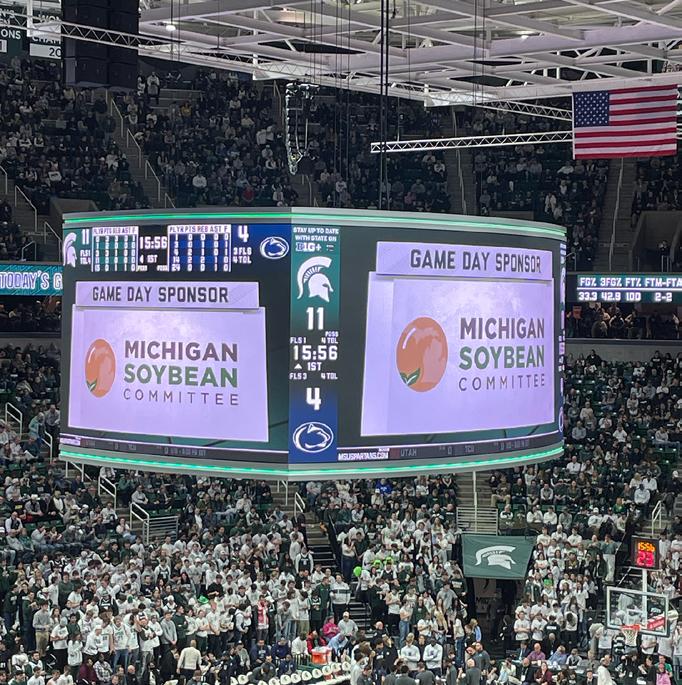





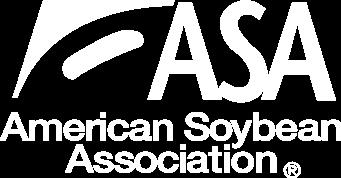


Michigan soybean farmers work tirelessly during harvest season, often spending long hours in the field and waiting in line at elevators. To show appreciation for their dedication and hard work, the Michigan Soybean Committee distributed over 1,000 harvest bags to farmers and truck drivers across the state this past harvest season. The bags, filled with a variety of delicious snacks and soybean checkoff information, were well received by farmers with many expressing gratitude for the unexpected surprise.
With harvest across the state finishing quickly this past year, MSC made a concentrated effort to hit as many elevators as possible. Elevators that received bags this year were:
• MAC - Brown City
• MAC - Marlette
• MAC - Breckenridge
• ZFS Ithaca - Ithaca
• Star of the West - Gera
• Star of the West - Richville
• Star of the West - Charlotte
• John Marion - Saline
• John Marion - Dundee
• Viterra - Saginaw
• The Andersons - Hemlock
• The Andersons - Oakley
• Van Gilder Commodities - Albion
• Van Gilder Commodities - Morrice
• Harvest Mills - Durand
• ADM - Webberville
The Michigan Soybean Committee remains committed to supporting our farmers in every way possible, whether through research, market development, or acts of appreciation like the harvest bags. We look forward to continuing this tradition and finding new ways to give back to all of our hardworking Michigan farmers.
We plan to continue harvest handouts next year, so if we didn't make it to your preferred elevator, there will be more chances in the future!
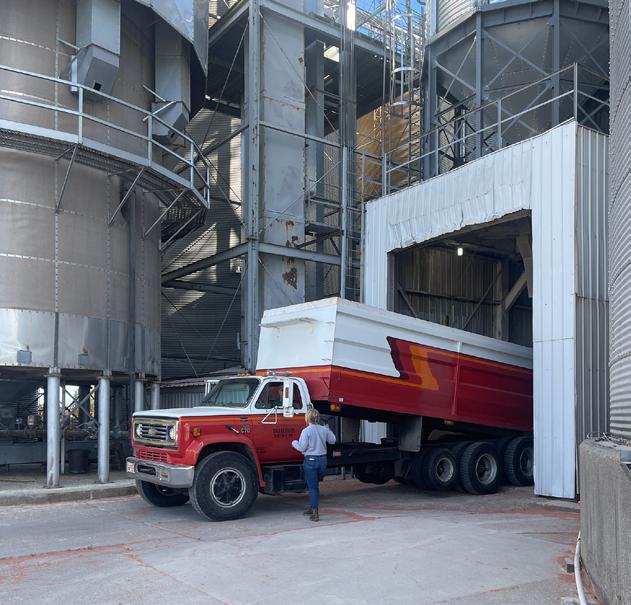
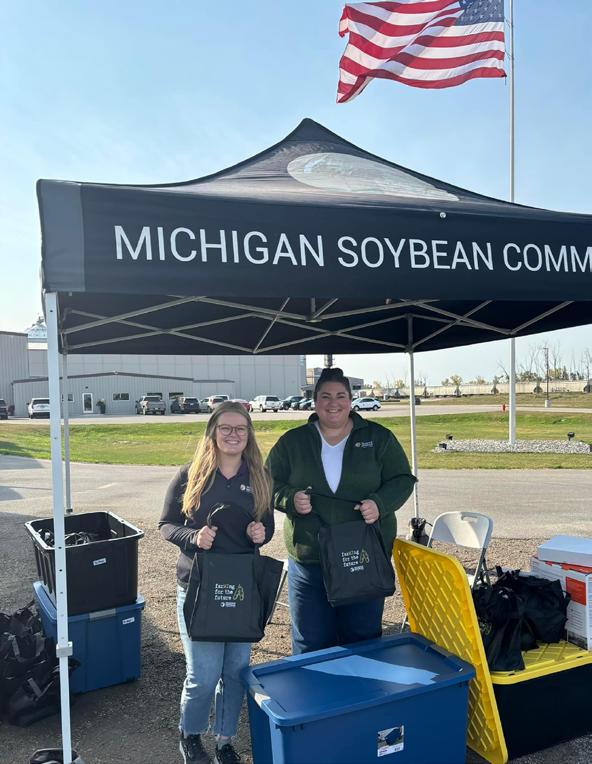
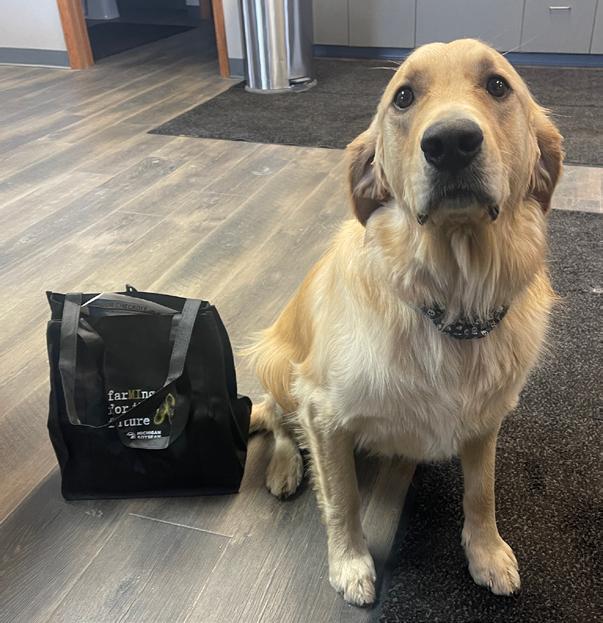


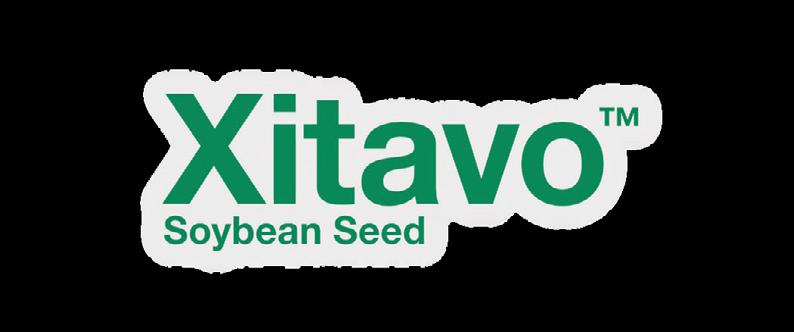


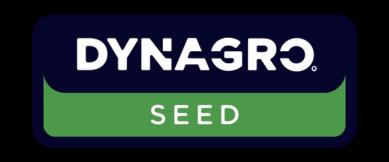

Dr. Kurt Steinke, MSU Soil Fertility & Nutrient Management Professor and Extension Specialist
Frustratingly simple or simply frustrating?
These two words often describe many of our thoughts on soybean nutrient management strategies, especially after the combine rolls through the field and yield data is analyzed. Soybeans can be great scavengers of nutrients and there are scenarios where merely planting and doing nothing can yield similar to the most progressive nutrient management strategies. However, this does not mean growers shouldn’t fertilize soybeans nor look for opportunities where a yield response and perhaps an improved return on investment may occur, especially with early season nutrient management strategies.
Greater early season dry matter production can support greater yield potential and thus further drive nutrient uptake. Many of us have seen these aboveground biomass responses to nutrient applications and the resultant “soybean bushes” that may be produced (Figure 1). However, soybeans, unlike corn, often demonstrate accelerated crop growth rates moving through the early to mid-R growth stages, which may eliminate or dissipate early to mid-season growth differences. Soybean nutrient uptake is similar to biomass production with more of a season long assimilation as the plant continues to grow with some uptake differences between individual nutrients.
Early-season nutrient management often includes some combination of pre-plant and or
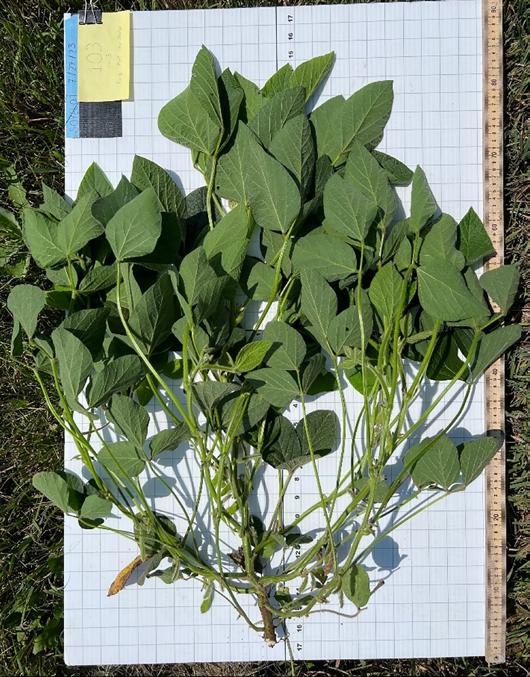
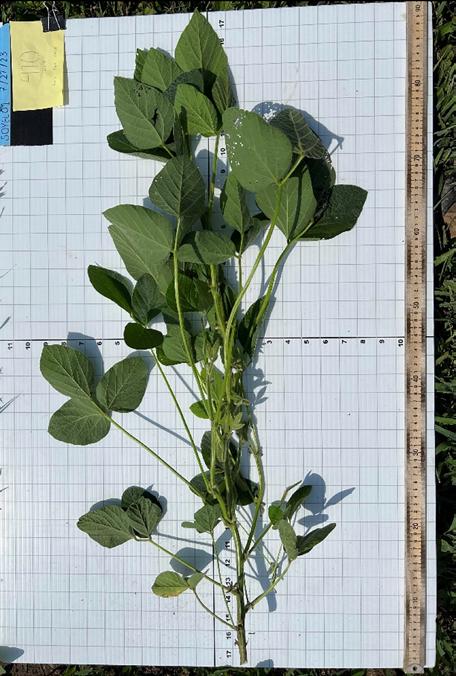
Figure 1. Differences in R3 soybean biomass production and anatomy. (25 lbs. N/A and 15 lbs. S/A) applied 2x2 (left) as compared to no fertilizer application (right) during the 2023 growing season. No yield differences occurred between the two treatments at harvest. (Lansing, MI)
at-plant fertilizer. When P, K and micronutrient concentrations exceed critical thresholds, the estimated potential for a yield increase as a result of the applications of these nutrients is around five percent or less. Low soil test phosphorus (STP) (<15 ppm Bray or <20 ppm Mehlich3) and low soil test potassium (STK) (<100 ppm on sandier soils or <120 ppm on fine textured soils) will benefit the most from pre-plant applications of these respective nutrients. Soils testing above these thresholds can frequently exhibit a biomass response to nutrient application, but a yield response, albeit possible, is low. If the goal is to increase soil test levels, a pre-plant broadcast application may be required. However, if soil test levels are sufficient, a banded application at a reduced rate or no application at all and simply drawing from what has accumulated in the soil may be acceptable options. Unless soil test K concentrations are quite limited, K application strategies in soybean often result in few yield differences. Remember that K is an earlier uptake nutrient in soybean with ~70 percent total K uptake by R4. Hence sufficient soil and tissue concentrations are essential for late-season grain fill and nutrient remobilization from plant tissues. Questions have been coming in on starter fertilizer for soybeans. The MSU Soil Fertility and Plant Nutrition program has focused on this area over the last decade with mixed responses. While starter fertilizer often gets referred to as a specific product or group of products, the term actually refers to a practice and not a product. The practice being fertilizer placed close to the seed at planting time with the sole purpose of giving roots early access to nutrients. Placement methods include in-furrow and multiple derivatives of the 2x2 (2 inches to the side and 2 inches below the seed). Reasons to consider starter fertilizer in soybeans as compared to the more conventional N-responsive crops (e.g., corn, wheat, sugarbeet) may include improved uniformity, addressing low-testing soil nutrient levels, micronutrient applications, improved nutrient use efficiencies, stimulating early growth during cool spring soil conditions, increasing both early and late-season nutrient availability, and mitigating inconsistent grain yield responses to foliar fertilizers as grain N, P, S, and Zn requirements derive from the soil after R5.5 and not vegetative
remobilization.
More recently, however, our program has looked at starter fertilizer as a tool to address some of the spring and summer climate variability. Over the last decade, growers have encountered spring drought, saturated soils, cool and warm soil temperatures, and scenarios where winter never really arrived. Our goal has been to develop the “start right capacity” for the soybean plant to capitalize on the early- to mid-season environmental conditions.
During the 2024 growing season, we focused on N and S starter applications as S is a co-factor for nodulation affecting N supply to the plant. Due to the influence of residual soil test nutrient concentrations on soybean yield response to nutrient applications, we looked at both a “less fertile” sandy loam and a “more fertile” loam soil to try and tease out a response. At the “less fertile” location, starter fertilizer (25 lb. N and 15 lb. S/acre applied 2x2) had a statistically significant 10.2 bushels per acre increase compared to the non-treated check. Greater rates of starter fertilizer also demonstrated significant yield responses but not greater than the rate evaluated above. At the “more fertile” location, positive trends in yield were obtained with starter fertilizer as compared to the non-treated check but were not quite statistically significant.
So why did starter fertilizer have such a strong impact during the 2024 growing season but only in some locations? June, July and August precipitation were above normal at this location with July and August rainfall totals nearly double the 30-year mean each month. The less-buffered soils at the “less fertile” location (i.e., CEC < 7) also contained well below two percent organic matter with no previous history of S applications. Plant tissue concentrations supported yield results with treatments not receiving S demonstrating below critical threshold S tissue concentrations. In fact, at the “more fertile” (i.e., CEC > 9) location, areas of the field with greater than two percent organic matter showed less starter response as compared to areas containing less than two percent organic matter. Soils containing less than two percent

organic matter, combined with nearly double the mean rainfall in July and August, likely resulted in the positive soybean S starter responses observed during the growing season. Should we expect this same yield response each and every year? Probably not. But there are opportunities as we witnessed in 2024 where growers can focus their soybean nutrient applications for greater yield gain.
Remember with in-furrow applications, total N and K 2O applied should remain < 5 lb./acre (total, not for each nutrient) with soil CECs < 7, while total N and K 2O applied should remain < 8 lb./
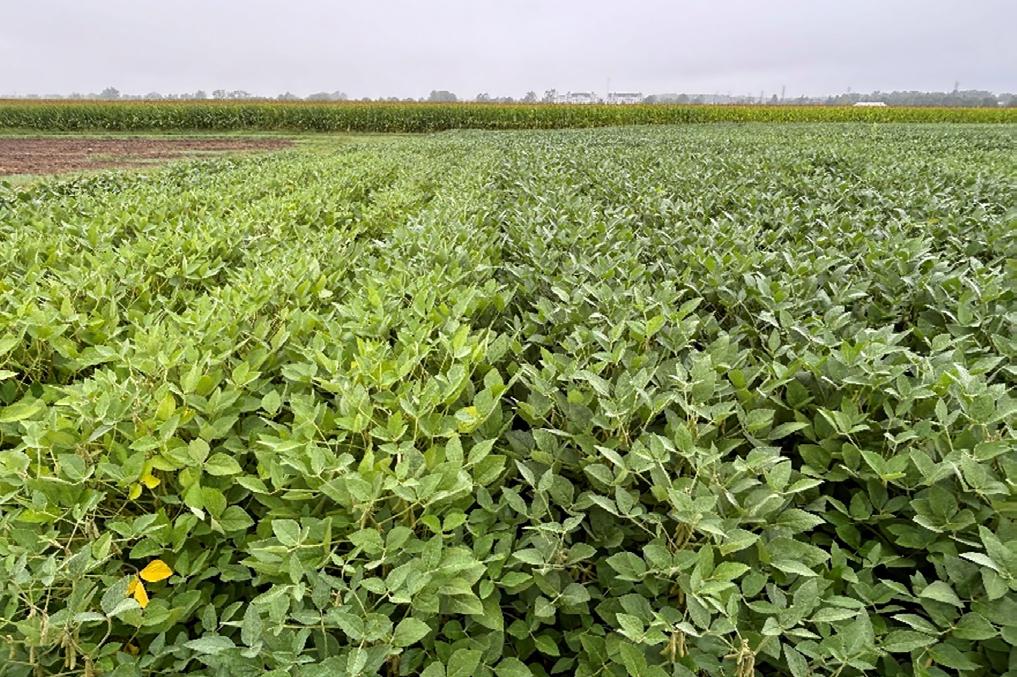
2. Differences in soybean response to starter N and S fertilizer during the 2024 growing season. Plot on left did not receive starter fertilizer while plot on right received 25 lb. N/A and 15 lb. S/A applied 2x2 at-planting. (Lansing, MI)
acre (total, not for each nutrient) with soil CECs > 8. These suggested thresholds will depend upon environmental conditions after planting as dry, warm soil conditions may still cause some damage, stunting, or stand loss at suggested rates. Subsurface banded applications (e.g., 2x2) have a larger window for safe nutrient applications due to greater distance from the seed. In these scenarios total N and K 2O applied to soybeans should not exceed 70 lbs./acre (total, not for each nutrient) for 30-inch rows. If MAP, DAP, or ammonium polyphosphate are used, suggested use rates decrease to around 20 lbs. N/acre or less. Thresholds will vary with other cropping systems including corn.
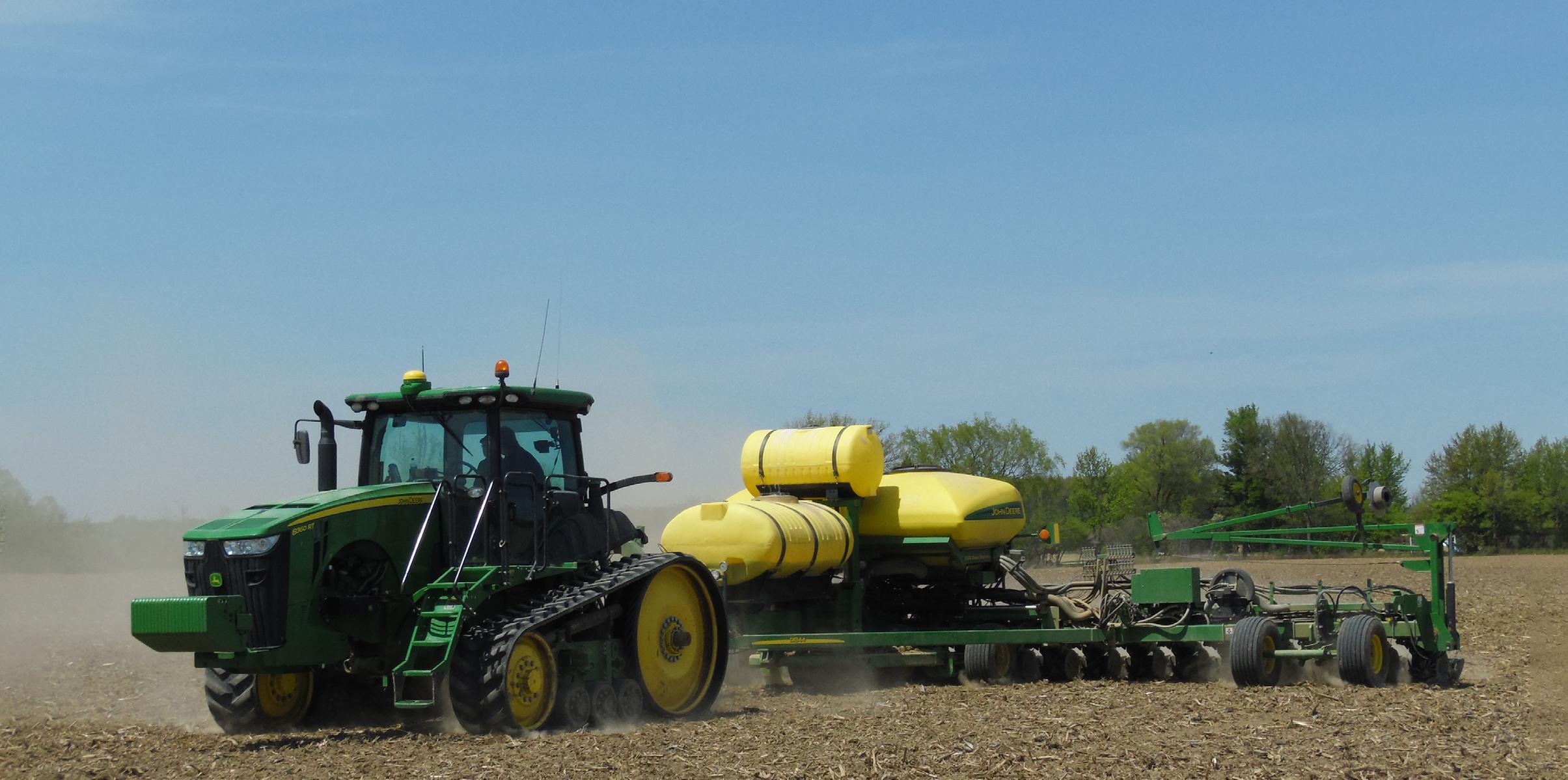

Virginia Houston, Director of Government Affairs, American Soybean Association
International trade is one of the pillars of the U.S. soybean industry.
Over 50 percent of the domestic soybean crop is exported to global markets annually, and continued access to those new, existing and international food aid markets are critical to sustaining U.S. soybean growers’ success. At ASA, we are constantly working with our partners in Congress, the administration, and soy industry colleagues at the World Initiative for Soy in Human Health (WISHH) and United States Soybean Export Council (USSEC) to promote soybeans in global export markets.
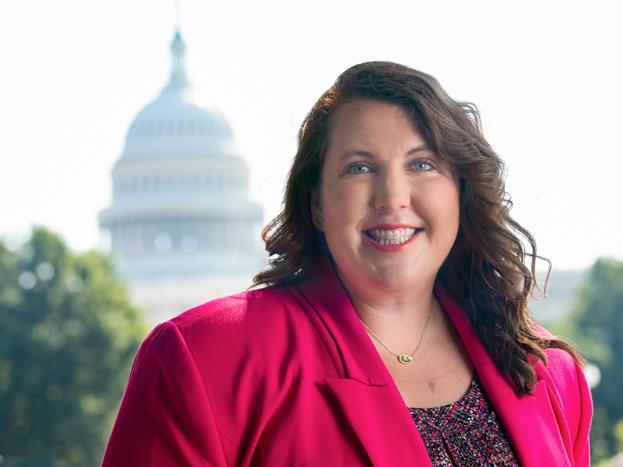
The long-term success of U.S. soy abroad would not be possible without the foresight of Congress to create export development programs through the Farm Bill. Resources provided through USDA are vital in assisting farmers with promoting agricultural products on a global stage and expanding and diversifying export opportunities. ASA is a long-time cooperator of these programs, particularly the Market Access Program (MAP) and Foreign Market Development (FMD) program. Utilizing MAP and FMD, ASA has leveraged these funds through WISHH and USSEC to increase market access, address technical barriers to entry and create on-the-ground capacity and demand for U.S. soy. These cost-share programs are an excellent example of public-private partnership.
Over the lifespan of these programs, however, industry funds have risen dramatically while funding from the U.S. government has remained stagnant. Seventy-seven percent of total annual spending on market development and promotion now comes from industry dollars, up from just 45 percent in 1996.
The 2018 Farm Bill made good progress in assisting export promotion programs by providing permanent baseline funding for programs like FMD, but there is still much work to be done. ASA has led efforts in the House and Senate to support a doubling of funding for both MAP and FMD, an issue that for years has been advocated for by agriculture stakeholders. We were grateful to Chairman GT Thompson’s (R-PA) support on this issue, and when the bill advanced out of the House Agriculture Committee last spring, both programs received the requested doubling of funds.
Unfortunately, that bill failed to advance in the House, and with a new Congress, the clock starts all over again on the Farm Bill. The groundwork laid in the 118 th Congress remains, however, and ASA is looking to keep forward momentum on these important export development programs.
USDA also created the Regional Agricultural Promotion Program, or RAPP, in 2024 to enhance the funds available for USDA cooperators like ASA. This program allows for new and innovative opportunities to grow demand in foreign markets, and U.S. soy has been awarded two rounds of funding under RAPP to complement ongoing work under MAP and FMD.
As we look ahead to (finally) getting a new Farm Bill across the finish line, funding for these trade programs will be top of mind for ASA. When export markets are threatened and soybean farmers are facing trade wars in major global export markets, programs like MAP and FMD are our best line of offense to grow new markets and create robust demand for our farmers. We look forward to working with our partners in Michigan to advocate for these programs in the next Farm Bill.


News about the 45Z Clean Fuel Production Credit has been making headlines for months, but what it means for soybean farmers is still somewhat unknown. 45Z is a significant policy aimed at reducing greenhouse gas emissions from transportation fuels. This tax credit, in place since January 1 st, replaced the 40a and 40b credits, and provides financial incentives to produce clean transportation fuels, including biodiesel, renewable diesel and sustainable aviation fuel (SAF), all of which can be made from soybean oil. Credit amounts vary based on carbon intensity (CI) of the fuel.
For soybean farmers, the 45Z tax credit presents both opportunities and challenges, with many key details yet to be finalized. One positive outcome from the interim guidance is that imported used cooking oil (UCO) is not eligible for 45Z credits. Imported UCO has become a major competitor of domestically produced soybean oil and the integrity of UCO imports has been called into question. This step towards prioritization of domestic feedstocks is encouraging for American farmers.
45Z incentivizes the use of climate-smart agriculture (CSA) practices, such as cover crops and no-till, which reduce the CI of soybean production and in turn the CI score of soybean oil. By adopting these practices, farmers can potentially receive a premium for their crops from biofuel producers seeking to qualify for the credit. This can help offset costs associated with implementing CSA practices and provide farmers additional revenue. An important change in 45Z from previous policy language allows farmers to implement just one CSA practice and participate, whereas previous policy required practices to be bundled.
However, to benefit from implementing these practices requires careful planning and data sharing. Farmers must be willing to share information about their practices with biofuel producers to ensure they meet the CI reduction requirements. Some farmers are already implementing recognized CSA practices, but for many this will be a new endeavor. To capture the value of a potential premium, some will need to invest in new equipment and others will have to revamp their data management systems. Despite these challenges, the potential for increased revenue
makes the 45Z tax credit an attractive opportunity for soybean farmers.
The lack of a final ruling on the 45Z tax credit is already impacting the biofuels industry. There is extreme uncertainty on which feedstocks biofuel producers should invest in. W2 Fuels in Adrian is one of two biodiesel producers in the state. W2 CEO Roy Strom recently made the decision to temporarily shut down for maintenance as he awaits more clarity. He shared, “I can’t justify operating our biodiesel plant, producing fuel and selling that fuel without knowing what the tax credit is really worth. My preference is to use domestically grown soybean oil, but with only interim guidance I don’t know how much margin, if any, there will be in soybean oil or any other feedstock.”
Many other biofuel plants across the country have significantly scaled back production due to the continued uncertainty. Complicating the situation for biofuel producers, there is no timeline for a final ruling. Strom feels a short-term fix could be to revert back to the 40a blenders credit that expired at the end of 2024, albeit with a few tweaks. “There is no perfect fix for this situation, however 40a offered us stability and clarity regarding the value of the tax credit and its impact on profitability. If we could go back to 40a for 2025 while the government sorts out their final guidance it would be very helpful. One ideal addition to a 40a extension would be an increase in the Small Agri-Biodiesel Producers Credit from $.10 per gallon to $.50. This would help level the playing field for soy-based biodiesel producers and offset some of the soy-based penalties currently in 45Z, such as Indirect Land Use Change.”
While the 45Z tax credit presents the potential for farmers to capitalize on the world’s growing interest in reducing greenhouse gas emissions, there are still many important details that need to be finalized. That same uncertainty plagues biofuel producers as they await final guidance to help determine which feedstocks to invest in.
As the implementation of the 45Z tax credit progresses, it will be essential for stakeholders to collaborate and ensure that the benefits of the credit are realized across the agricultural and biofuels sectors.

In the last five years, soy checkoff investments have generated a 4.5-to-1 ROI in export market development and an 18% increase in U.S. soybean exports.1 Investing $400,000 for infrastructure research, analysis and design at the Port of Gray’s Harbor helped to expand the facility and increase capacity for the export of soybean meal.2 1



On December 11 th and 12 th nearly 85 members representing Midwest agricultural and transportation sectors met in Dearborn, MI for the first annual gathering of the Great Lakes Alliance for Sustainable Shipping, also known as GLASS. GLASS is a new coalition launched by the Michigan Soybean Committee focused on driving collaborative conversations between all facets of Great Lakes shipping to inspire a more efficient, economical and sustainable future. By working together to surface issues and solve problems, the Great Lakes region can advance in the areas of economic vitality, agricultural prosperity, infrastructure development and environmental stewardship.

Attendees of the inaugural event included representatives from Michigan Agricultural Commodities, Star of the West, The Great Lakes Saint Lawrence Seaway, Ports of Indiana, Interlake Maritime Services and many more. The group spent time hearing from experts on efforts to streamline and diversify shipping of agricultural products in the Midwest while working to meet sustainability targets. Included in the meetings was time for small group facilitated discussions which helped the group gain insights on both bottlenecks and opportunities that exist in the Great Lakes transportation industry.
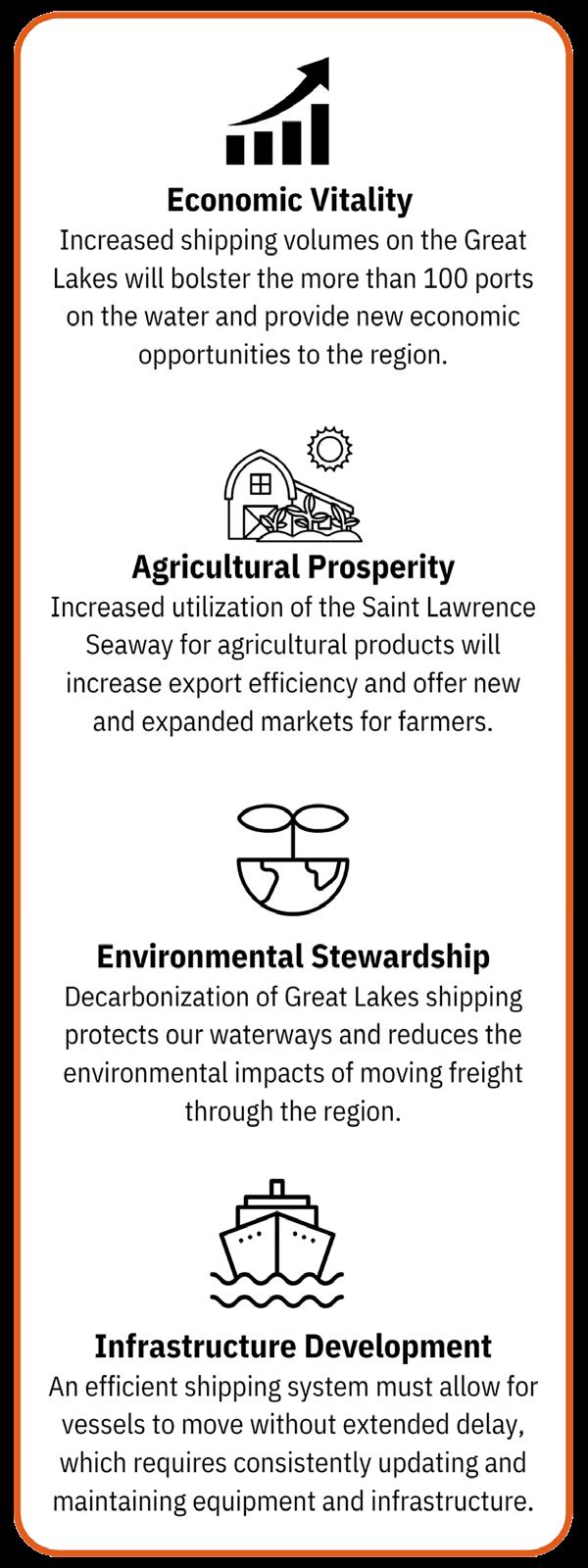
Over the next year, the working groups formed from this event will meet quarterly to work on goals surrounding price transparency and availability for shipping on the Great Lakes Saint Lawrence Seaway, surveying current marine infrastructure capabilities for shipping agricultural products, spreading information about agricultural products available for export from the Midwest and creating educational materials to help the marine industry understand and adopt biodiesel.
At the end of 2025, the group will reconvene to discuss progress on these goals and set new ones. While this inaugural meeting focused on marine shipping on the Great Lakes, we look forward to expanding into on-road and rail transportation. If you are a farmer with specific interest in any of these modes of transportation and want to get involved, please contact Hanna Campbell at hcampbell@michigansoybean.org for more information about GLASS.


Aspecialty, food grade soybean producer from Charlotte, MI has been appointed to the U.S. Soybean Export Council (USSEC) Soy Foods & Oil Strategic Utilization Team (SUT). Gary Parr will sit on the SUT for the next two years to provide insights and feedback on USSEC International Marketing efforts surrounding food grade soybeans and oil. Parr is perfectly suited to represent Michigan as he has grown food grade soybeans for over 20 years and has hosted many international trade teams on his farm.
Parr says, “I hope to gain a better understanding of export opportunities for U.S. soy. I look forward to providing a soybean grower perspective on issues regarding new and existing marketing for food grade soybeans and oil.”
Michigan Soybean Committee is also well represented on the USSEC Soy Excellence Center (SEC) Global Advisory Panel by David Williams of Elsie. Dave is starting his second term on the GAP where he will provide strategic guidance and oversight into USSEC’s international education and training programs that help build confidence in U.S. soy.
“Representation on the USSEC board keeps Michigan soybean farmers 'in the loop'. Soybean exports are increasingly crucial to Michigan’s growers because we produce more than we can use domestically. USSEC provides resources to our international customers, with regional staff that provide expertise in soy utilization. The SEC is yet another USSEC resource. These efforts all help build a preference for US Soy,” shared Williams.
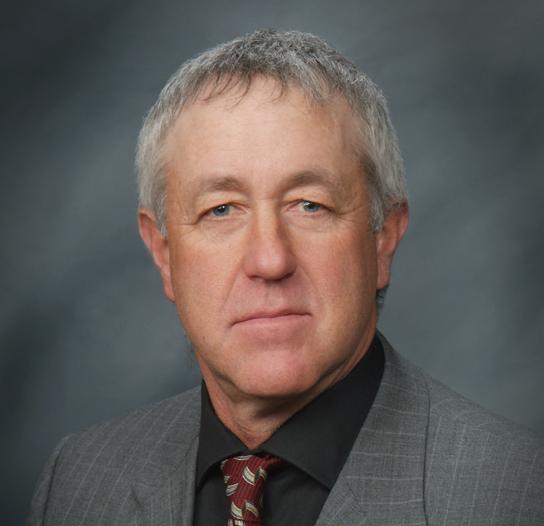











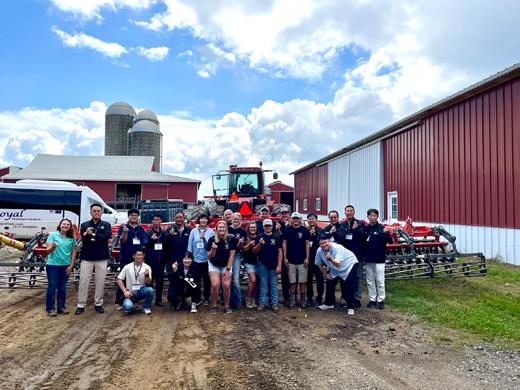
The majority of the market share of food grade soybeans used in Japan are soybeans imported from the U.S. It is important for Michigan, as a key grower of specialty and food grade soy, to support the continued growth of this market to ensure premium opportunities for our MI soybean growers.
MSC has been partnering with the U.S. Soybean Export Council (USSEC) for three years on a project to highlight Michigan specialty soybeans, like natto, to Japanese buyers. In 2024 USSEC partnered with the Japan Natto Association to help promote Michigan and U.S. origin natto soybeans directly to importers and manufacturers. This project also helped support the 13 specialty soybean buyers that visited Michigan in the summer of 2024 to tour natto and tofu soybean farms.
product can be a big cost savings from what we are currently doing to extend service life. A big thank you to everyone that help with our project. We are extremely excited to see how BIORESTOR will perform on our pavement. If our road agency sees good results, we will be applying it to all of our newer pavements over the next few years.”
MSC will be collecting coring data from this application over the next few years to see how BIROESTOR performs overtime on a busy road in Michigan weather conditions.

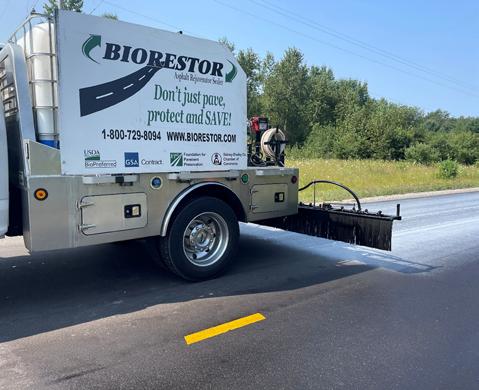
BIORESTOR Asphalt Rejuvenator is a restorative asphalt modifier that has been shown to increase pavement life cycles by up to 40 percent when applied at the right time. BIORESTOR does not just top the asphalt, it penetrates to restore the pavement from within by decreasing the brittleness of asphalt pavement to improve flexibility and decrease cracking. MSC has partnered with county road commissions across the state to test this product. One of our applications in 2024 was done on Maple Ridge Road in Arenac County.
Brad Stauffer, Managing Director for the Arenac County Road Commission shared, “Our road agency is always looking for products and ways to lengthen the service life of our pavements. We are eager to see if BIORESTOR is that product for us. This
The Michigan Soybean Committee has partnered with the World Initiative for Soy in Human Health (WISHH) for many years to help develop previously untapped trade opportunities for U.S. soy. By working in developing and emerging export markets that show promise for long-term development, WISHH positions American soybean farmers as the choice provider of protein. During times of trade instability, it is so important to foster a dynamic and diverse export system.
In 2024, WISHH worked with 35 new organizations to help foster these new trade relationships. These organizations span the entire globe including Africa, Asia and Latin America. WISHH reports that 90 percent of WISHH program participants reported that they understood the nutritional, economic or functional benefits of using soy in food or feed. This trust in American soy led to 98 percent of their target audience in developing and emerging country market sectors indicating that they would continue or expand their use of U.S. soy products.
If you are a farmer interested in learning more about MSC’s market development projects or want to get involved in our efforts, please contact Hanna Campbell, MSC Market Development Director at hcampbell@michigansoybean.org

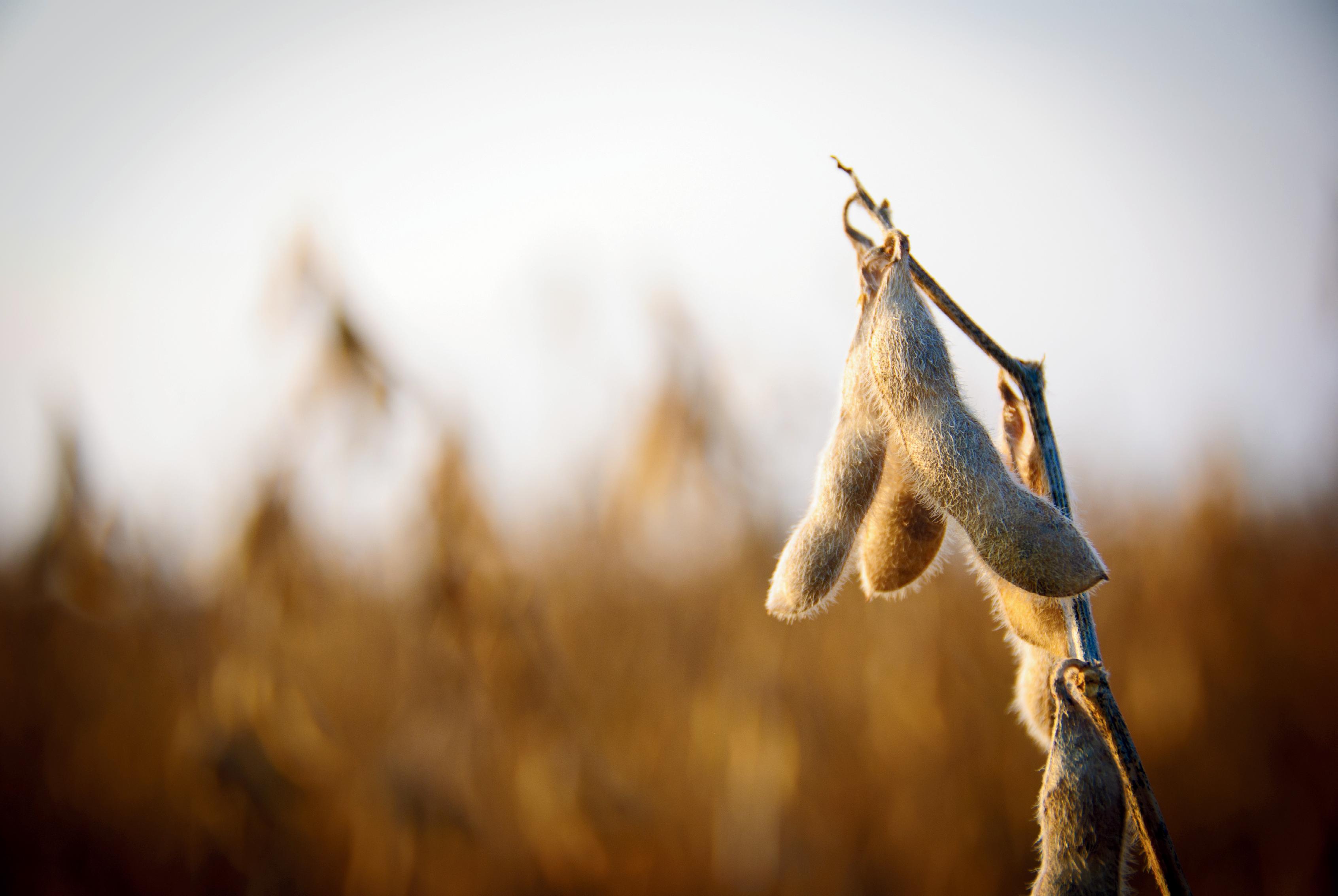
The MISOY PAC was established in 2024 and is the only political action committee that solely represents the interests of Michigan soybean farmers. The MISOY PAC provides the Michigan Soybean Association with resources to support Michigan legislators who advance soy farmer priorities.
MISSION: The mission of the MISOY PAC is to utilize contributions in a strategic way that strengthens and supports our relationship with policy makers to advance the soybean industry and to benefit Michigan soy farmers.
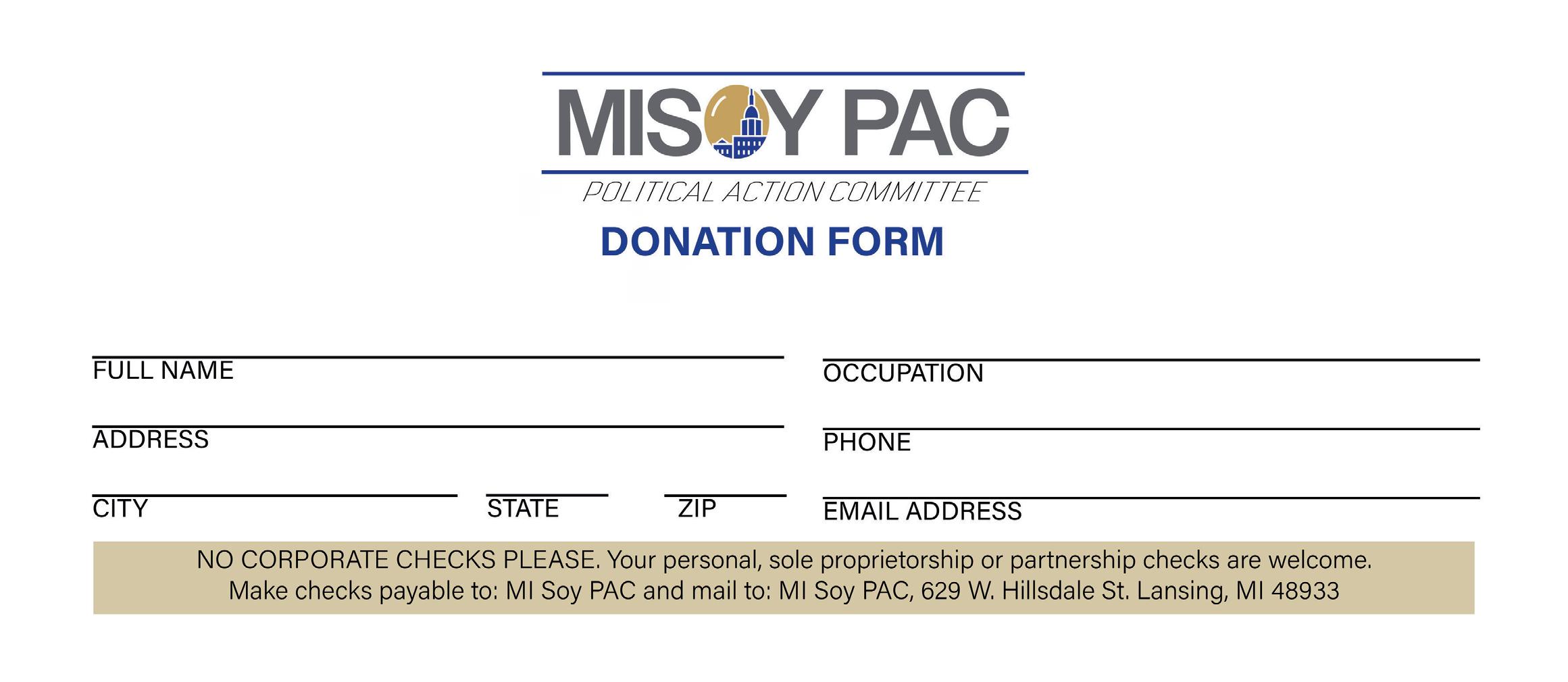


On February 5th the Michigan Soybean Committee and Michigan Soybean Association partnered with the Michigan Agri-Business Association (MABA) to present their first Ag Club Breakfast meeting of 2025. This is a long-standing partnership between our three organizations to ensure the Michigan agricultural business and legislative communities stay up to date with the issues and opportunities set before our soybean industry.
This year’s MABA presentation featured a unique food-grade specialty soybean product that is grown by farmers in Michigan called natto. Natto is a traditional Japanese food made from fermented soybeans. It is stringy, sticky and is one of the few processed soy foods where the entire soybean is eaten. In addition to its interesting nutty flavor, natto also has a great nutritional profile and is regarded as a superfood. A good U.S. comparison to natto may be greek yogurt, which is enjoyed by many at breakfast and is high in protein, calcium and probiotics.

Japan imports roughly 156,000 MMT of U.S. soybeans for natto every year, and the U.S. holds about 70 percent of the market share used for making natto in Japan. Michigan’s growing environment is great for growing specialty soybeans and in 2022 MSU found that over seven percent of soybean grown in Michigan were considered “specialty” varieties. Charlotte, MI natto grower Gary Parr spoke during the breakfast about how growing natto soy differs from other varieties and shared information on the premium that farmers can capture by growing specialty soybeans.
Over the last year, natto has increased in popularity both in Japan and in the United States. Natto has recently gone viral on social media platforms like TikTok where people post videos called mukbangs trying natto for the first time and experiencing its distinctive texture and flavor.
If you are interested in trying natto for yourself, you can visit the frozen section of a local international grocery store. Natto is normally found in single serving Styrofoam containers. When you open the container, it's recommended to stir the soybeans at least 50-100 times until they are light and foamy. Make sure to pair your natto experience with some of its common toppings like soy sauce, spicy mustard, traditional Japanese mayonnaise, avocado and more.
If you're interested in the full presentation we shared during the breakfast, you can view it by scanning the QR code below.

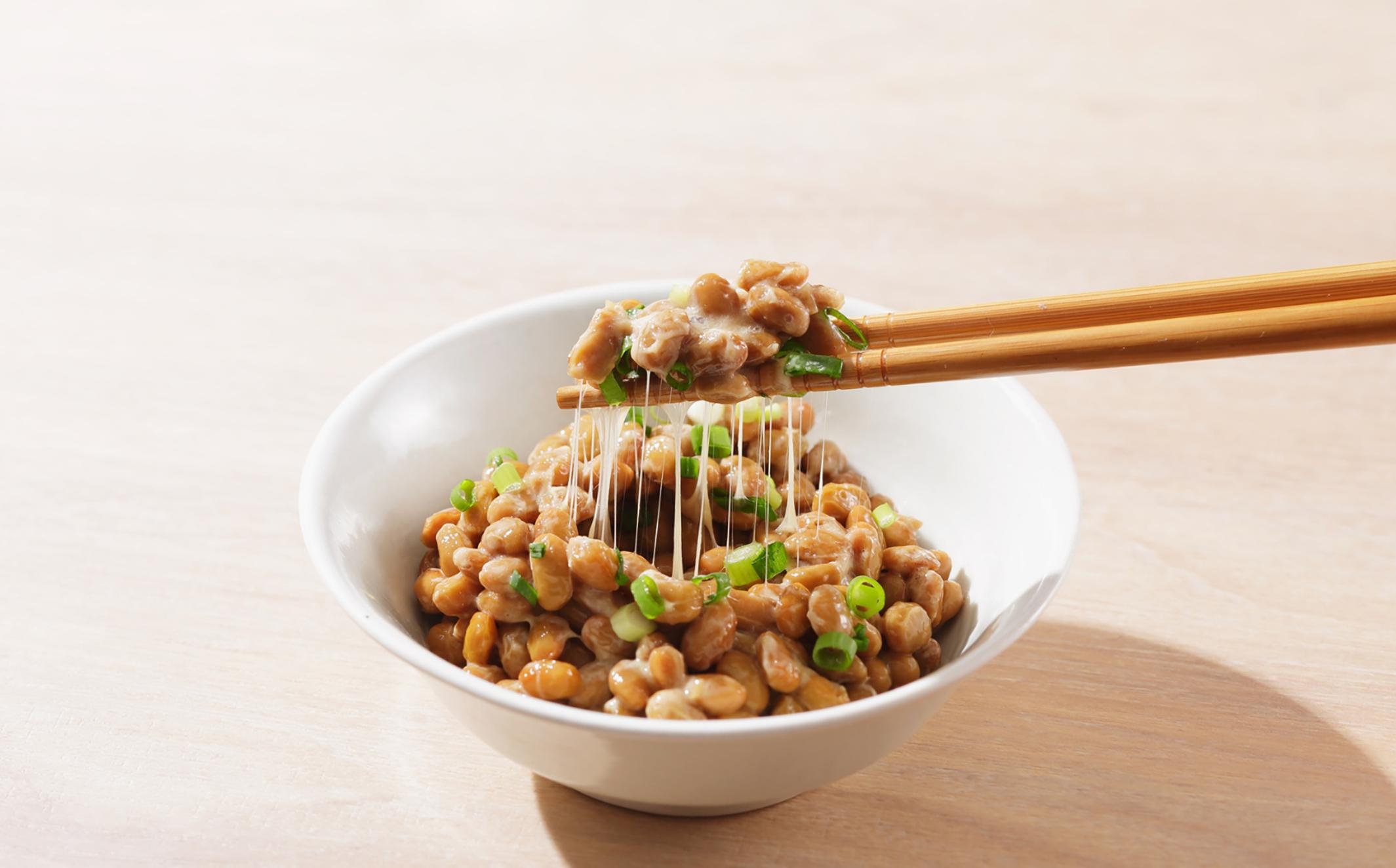

Dr. Chris DiFonzo, MSU Field Crops Entomologist
After every winter cold snap like the one in January, I get the question ‘Did the cold weather kill XYZ (insert name of least-favorite soybean pest)?’. The assumption (hope) is that more dead insects in January = fewer pest problems in June. The quick answer is ‘probably not’.
Short winter cold snaps kill fewer insects than you might expect, because overwintering insects use special strategies to survive. Many accumulate antifreeze in their cells in the fall. These specialized ‘cryoprotectants’ lower the freezing point of the body fluid and prevent the formation of damaging ice crystals. Aphids are an example of a pest group that uses antifreeze to survive the winter. The overwintering eggs of many aphid species, including soybean aphid, contain glycerol or mannitol. These compounds allow soybean aphid eggs, laid on exposed
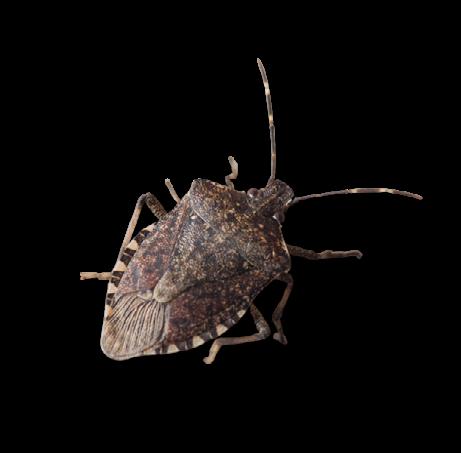

When our members are successful, we’re successful. This year we’re celebrating returning over $1 billion total back into the hands of our members over the last 20 years and showcasing the billions of ways that partnership with GreenStone pays. With locations across Michigan and northeast Wisconsin, we’re here when you’re ready to talk.



branches of buckthorn trees, to supercool to a chilly -29°F. The overwintering eggs of slugs also contain cryoprotectants to protect them from below-freezing temperatures. Overwintering adult slugs may die but the eggs survive to hatch in May.
In addition to accumulating antifreeze, many insects avoid severe or fluctuating temperatures by overwintering in protected places. For example, white grubs move 8-12 inches down the soil profile in the fall and stay there until spring. Seedcorn maggots overwinter in a protective pupal case up to 6 inches below the soil line. Adult bean leaf beetles can be killed by temperatures below 15°F, but they avoid exposure to such extremes by overwintering in leaf litter or crop residue on field edges where it rarely gets that cold.
Thus, insects that overwinter in Michigan evolved to survive cold temperatures. In fact, they evolved to withstand colder conditions than we experience today, since our average winter temperature has risen 3°F since the mid-1960s. Unless the winter season is very cold for an extended period, many insects survive until spring.
If winter weather isn’t the biggest factor, what sets the stage for insect outbreaks in soybeans in the summer? What happens in spring is key. If there are favorable conditions early, the high reproductive capacity and mobility of insects can result in large populations in some fields later in the year. Favorable conditions differ by species. For example, seedcorn maggot infestations occur where green cover crops or fresh manure are tilled into soil and soybeans are planted shortly after. This is because adult flies are attracted to such fields for egg laying. Stink bugs feed in small grains early in the season, then move in high numbers to adjacent bean fields after wheat harvest. Spider mite outbreaks in August occur after hot, dry weather in June and July.
In summary, insects that overwinter in Michigan have multiple ways to survive the cold. If conditions are very cold for an extended period, overwintering insects may die. But things aren’t that simple – survivors can reproduce quickly under favorable conditions early in the season and lead to infestations later in the season.


It was another year of record attendance at the Great Lakes Crop Summit.
Drawing over 1,200 farmers and agri-business leaders to Mt. Pleasant, MI, in January, this conference continues to highlight key industry issues and foster farmer networking opportunities. This annual conference brings together soybean, corn and wheat farmers from across the state and features many educational sessions along with a trade show featuring more than 60 agricultural business representatives.
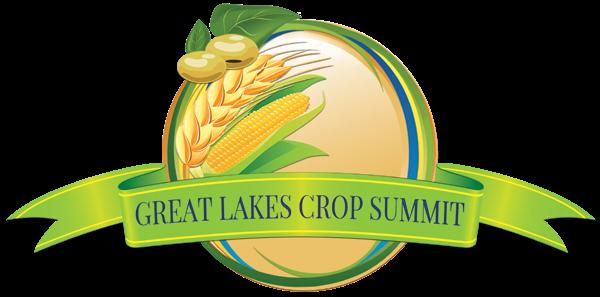
Soybean breakout sessions included information on establishing soybeans in high residue fields, pushing the maturity group boundaries of soy and strategies to address those hard to fight weeds.
This event is hosted by the Michigan Soybean Committee, Corn Marketing Program of Michigan and Michigan Wheat program. Other sessions discussed spray barn safety and how to prepare for the worst day on your farm. Sessions like these highlighted the importance of farm safety and having a well thought out plan. Attendees also attended sessions on the use of drones on farms, learned more about biologicals, heard industry's goals for decarbonization, and got tips on proper fertilizer management.
Farmers also heard from keynote speaker Jim Wiesemeyer on how farmers can prepare for a new wave of farm policy, trade efforts, energy and the economy. Another keynote panel, featuring leaders from our state commodity checkoff and association programs, focused on the market development, production research and communication efforts done in MI to support farmers.
Ben Steyer, Michigan Soybean Committee CEO, shared, “We continue to strive to make GLCS an annual event that informs farmers and prepares them for the growing season ahead. This is the only Michigan event tailored specifically to the needs of row crop farmers, and we thank our farmers for their continued attendance and support.”

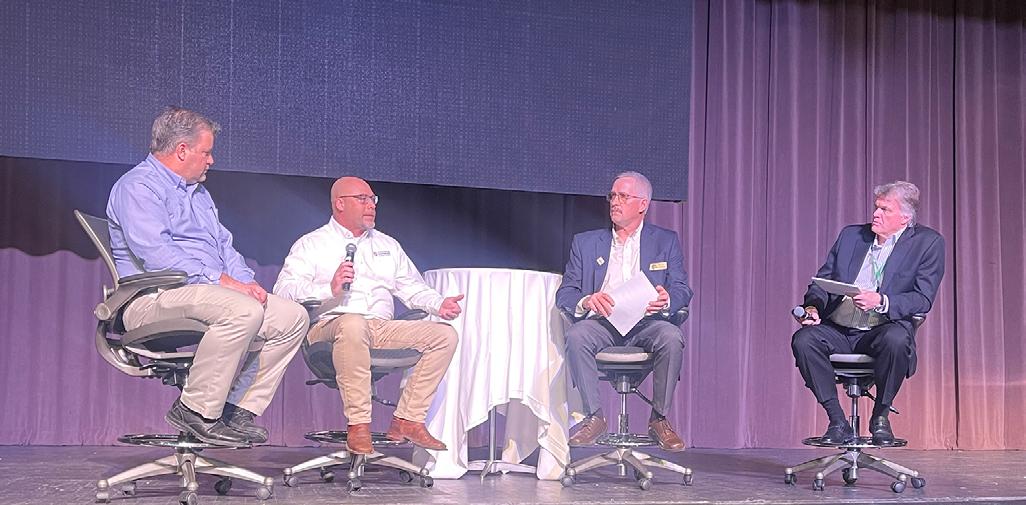
MSU Extension Field Crops Team
ATTENTION All Michigan grain and field crop producers, agribusinesses and organizations — MSU Extension needs your input!
Every 3 years, the statewide MSU Extension Field Crops work team asks Michigan field crop producers to help us understand the current needs and interests of their industries. We do this by preparing a short questionnaire and seeking responses from farmers, processors, ag suppliers and support organizations.
We use the information we receive from throughout Michigan to assure that current MSU Extension programs are on-track, and then work to develop new programs that will be meaningful to the people we serve. Your individual response will be confidential.
This year, to encourage participation, you have the option to be included in a drawing for a $100 gas gift card. Three cards will be awarded to randomly selected people that complete the online questionnaire and ‘opt-in’ for the drawing.
To complete the online MSU Extension statewide field crops needs assessment survey, please visit bit.ly/FieldCropsNeeds or use this QR code to access it on your smart phone. Thank you!



Much work has already been done to prepare for a successful soybean production season. Seed dealers have been consulted and varieties/maturities/traits selected, fertilizers purchased and applications planned or made, crop protection chemicals purchased, planters maintained, and many other steps. As we head into planting season, another set of management decisions needs to be made: tillage, planting date, seeding rate, seed treatments, starter fertilizers or other growth-promoting products, etc. Various MSU specialists and educators have conducted MSC-funded research over the years to help with these decisions, and a quick search on the MSU Extension website and the MSC website will help you access those results.
The Science for Success team of University soybean specialists from around the country have identified planting date as one of the most important factors affecting soybean yield. This article will focus on planting date with MSC-funded research results from three sources: MSU’s cropping systems agronomist Dr. Manni Singh; Missy Bauer of B&M Crop Consulting; and the Michigan Soybean On-Farm Research program.
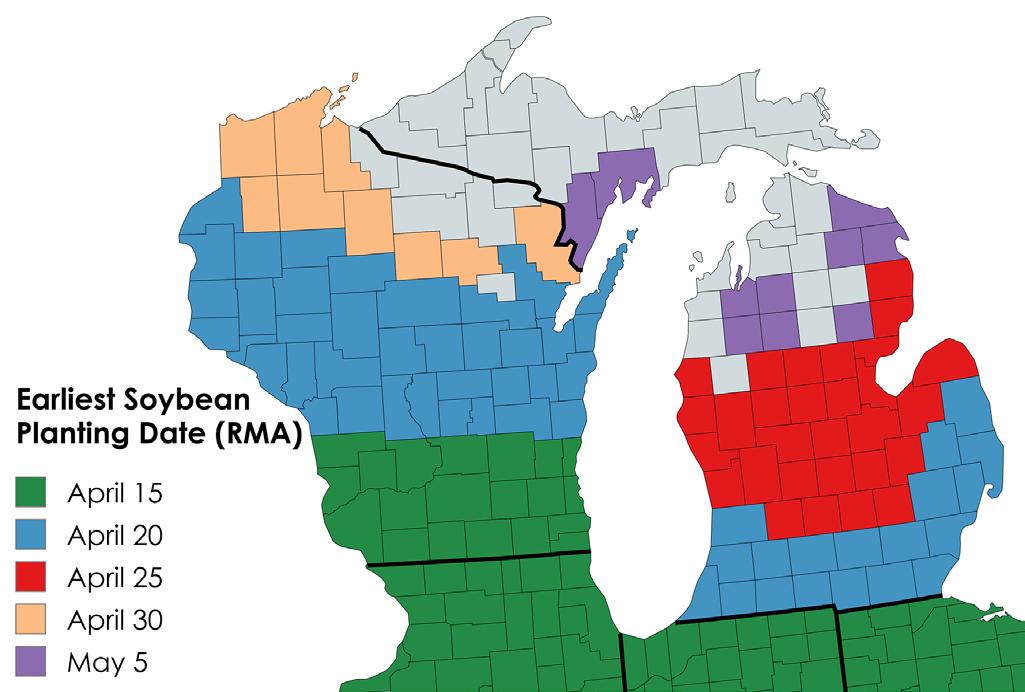
In 2023, researchers with the Boots on the Ground benchmarking project, funded by the North Central Soybean Research Program (NCSRP), worked with USDA’s Risk Management Agency (RMA) to adjust the earliest soybean planting dates to utilize crop insurance for replant coverage in many regions, including Michigan. Now most Michigan soybean farmers are able to plant as early as April 20 or 25, depending on location, and still opt for federal crop insurance (Fig. 1). The researchers found a two to three bushel per acre decrease in yield potential occurs in Michigan with every week of planting delay past around April 25 th. Singh’s small-plot research has produced similar results with a smaller penalty found earlier in the season and increasing later in May (Fig. 2).
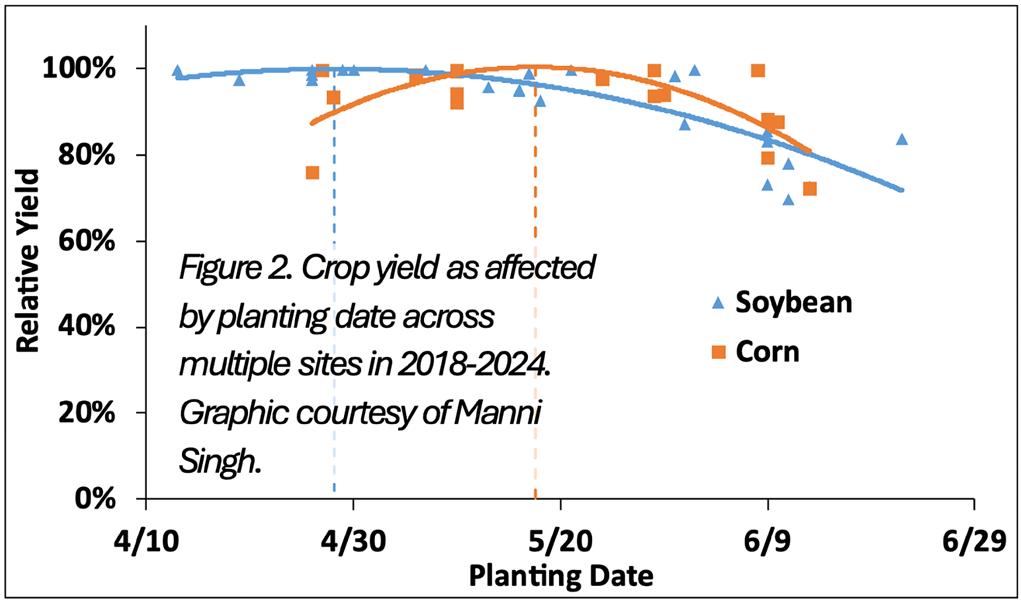
On-farm research results have shown the same trend of higher yields with earlier planting. Singh found 16 of 34 sites from 2019–2021 had significantly higher yields with earlier planting (roughly three weeks) and only two sites with significantly lower yields (Fig. 3). Bauer found a 4.6 bushel per acre advantage on average when planting in late April or early May compared with planting after May 15 from 2017–2019 with no sites having significantly lower yields with the earlier planting. In a separate

study, she found a 4.1 bushel per acre advantage on average of planting April 15 or 22 versus May 6 or 7 in 2023–2024. In the Michigan Soybean On-Farm Research program, 10 of 25 sites had significantly higher yields and only three sites had lower yields with earlier planting (2–3 weeks earlier than normal) from 2019-2023 (Fig. 4).
Planting early, although likely to result in higher yields, is not without risks. Key caveat: none of the researchers recommend planting early unless soil conditions are right. Creating ruts, compaction/sidewall smearing, and open seed trenches will likely cause problems that will more than negate any yield advantage of planting early. Soil temperatures should be approaching 50°F and rising, and planting should be avoided if rainfall is

expected within 24 hours with cold air temperatures to avoid seedling injury due to imbibitional chilling - that “first drink” for the seed being too cold. If we have an early spring and all these conditions are right in the first half of April, ultra-early planting may be considered. Bauer’s research has found planting in the first half of April compared with planting in late April or early May resulted in higher yields 85 percent of the time and an average yield advantage of 1.7 bushels per acre. Lower yields resulted when frost events were severe, and one field needed to be replanted. Just remember that federal crop insurance for replant coverage is not available with ultra-early planting.
One of the main risks to early planting is a frost/freeze event after seedlings have emerged. Unifoliate leaves or cotyledons subjected to 29–30°F temperatures are likely to experience injury while true trifoliates can be damaged at temperatures below 32°F. Also expect seeds to be in the ground for two weeks or longer with early planting, so consider using a fungicide seed treatment, perhaps a premium package with ultra-early planting, and including a product such as ILeVO or Saltro in fields with known sudden death syndrome.
Thanks to Dr. Manni Singh and Missy Bauer for contributing to and reviewing this article.
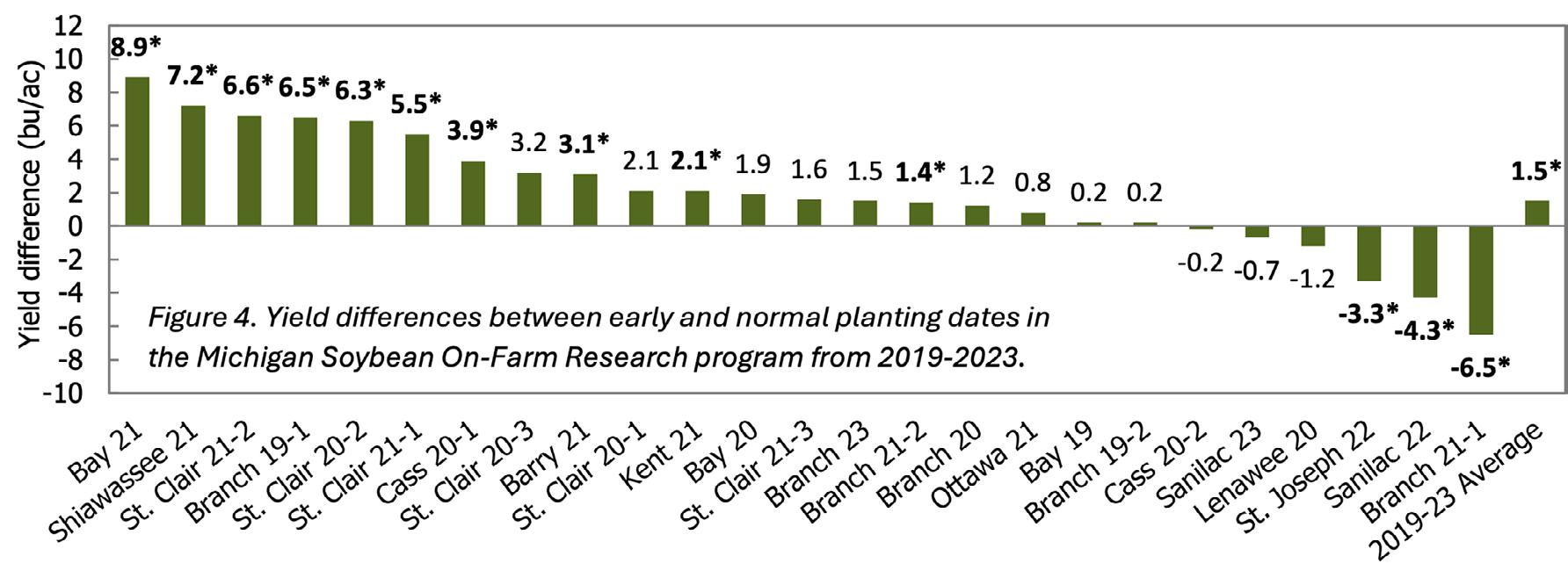

WISHH leverages partnerships for U.S. Soy to help meet the protein needs of 8 billion consumers




Once your soybeans are harvested and delivered to the elevator, where they head next? Beyond that, do you know what your soybeans are made into?
In 2024, the Michigan soybean harvest was expected to be 111 million bushels, up significantly from 2023. With this increase in soybean production, it is more important than ever to have an efficient transportation and processing system to help move beans from the farm to the elevator and from processors to those in the next steps of the value chain. In order to increase the efficiency of the system, we first need to take a look at the current pain points and where there are opportunities for advancement. For this reason, MSC has decided to take a look at key parts of the Michigan soy value chain during our latest 13-week podcast series with Brownfield Ag News.
This series kicked off with MSC Market Development Director Hanna Campbell giving an overview of the Michigan soy value chain and the possible roadblocks that soybean farmers may face. This episode teed up the series that will go on to cover the entire value chain from farm to end user and how farmers can position themselves and their processors to take advantage of the market.
In week two Jim Sutter, CEO of the U.S. Soybean Export Council, gave details on where Michigan soybeans are exported to and the steps in the supply chain that help get them to end users. Sutter focused in on the trip Michigan beans take all around the world, with about 30 percent of Michigan’s whole bean and 20 percent of meal exports going to Canada.
In upcoming episodes Michigan farmers, soybean processors and transportation sector representatives will be highlighted. Make sure to visit brownfieldagnews. com/misoy or scan the QR code to the right to listen in and learn more about the movement of your soybeans and how your soybean checkoff is working to help to increase the efficiency of the transportation system.
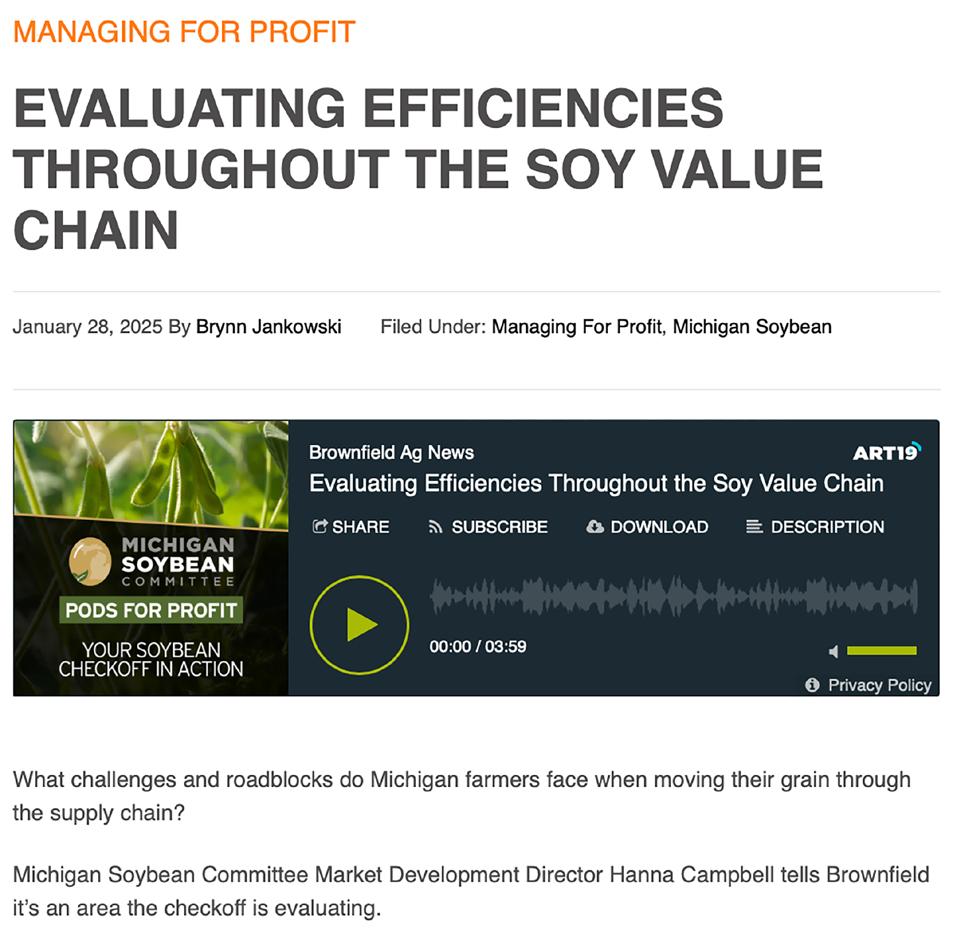

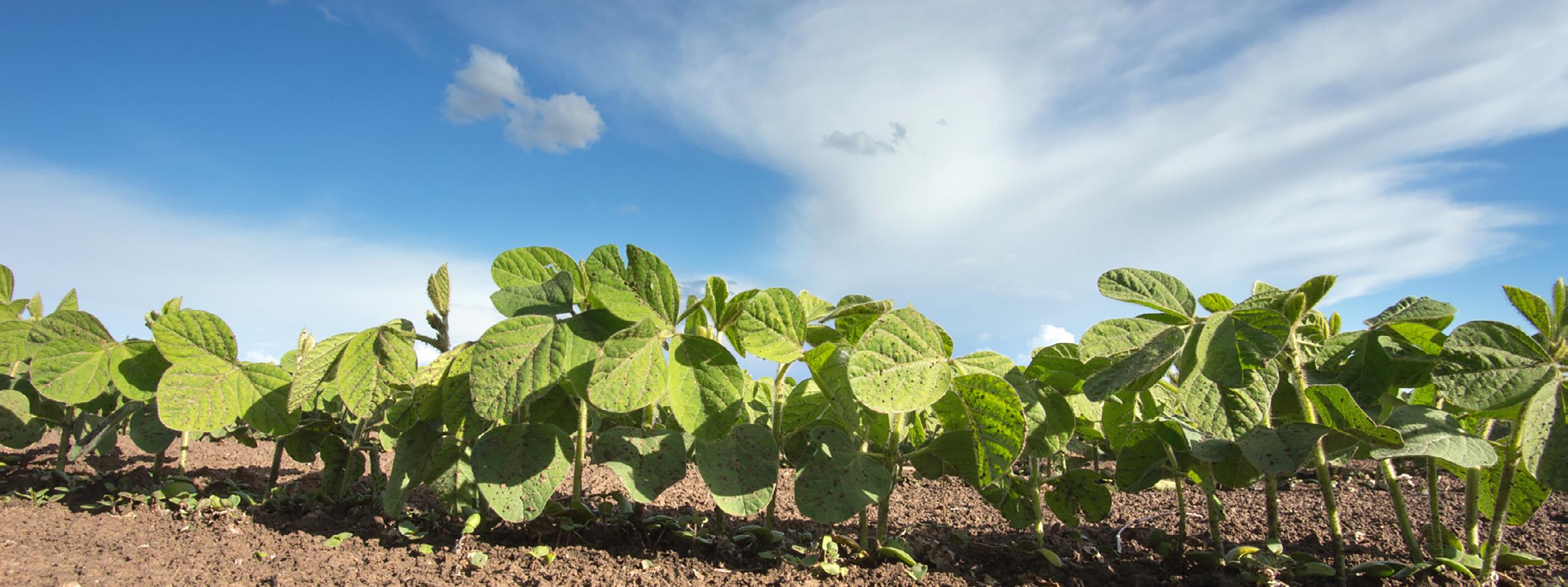

At Asgrow® brand, not only are we all about the beans, we’re all about your success as well. That’s why we o er localized products with leading genetics, weed management systems and maximum pro t potential – all developed by soybean experts who put soybeans rst.
DISCOVER HOW IT’S ALL ABOUT THE BEANS. Asgrow.com
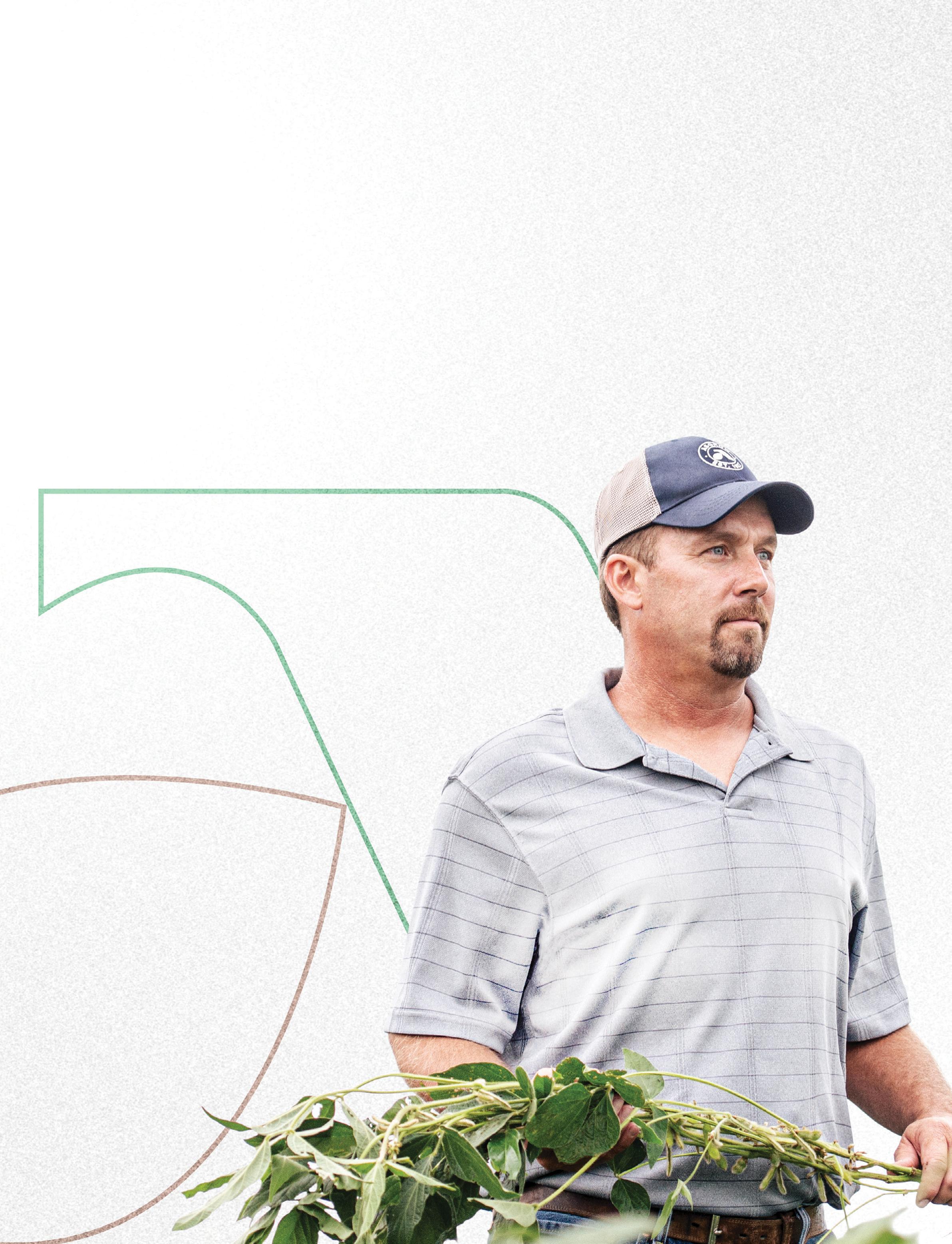



Razieh Yazdani, Research Associate and Dr. Marisol Quintanilla, Assistant Professor
Soybean breeders have made progress in integrating a new soybean cyst nematode resistance source (Peking) into high yielding soybean varieties. In the past 30 years, SCN resistant soybean varieties have nearly all included one source of resistance: PI 88788. This source has been a great service to U.S. soybean growers as it has protected most fields from significant yield losses and slowed increases of SCN populations. While that is good news, the bad news is that soybean cyst nematodes have now figured out how to reproduce on PI 88788 varieties.
As the Peking source of resistance becomes more readily available these soybean varieties have helped to reduce SCN populations and increase soybean yields in SCN infested fields. However, even with these additional options, Peking has shown it is not as durable in controlling SCN under continuous use.
MSC-funded research by Dr. Marisol Quintanilla at MSU has shown that Peking initially controls SCN but the nematodes breakthrough the resistance more quickly. Therefore, rotating resistant varieties is a key strategy. Continuous use of a single resistance source, such as PI 88788 or Peking, can lead to resistance breakdown.
Dr. Quintanilla advises growers to use the following strategies to minimize yield loss and control SCN populations:
Soil testing and HG Type identification are essential steps. Farmers should test soil for SCN presence and population levels before making planting decisions.
Use SCN resistant varieties but don’t overuse Peking varieties. Avoid the back-to-back use of Peking in a specific field. Rotate PI 88788 with Peking varieties to keep SCN populations from building resistance.
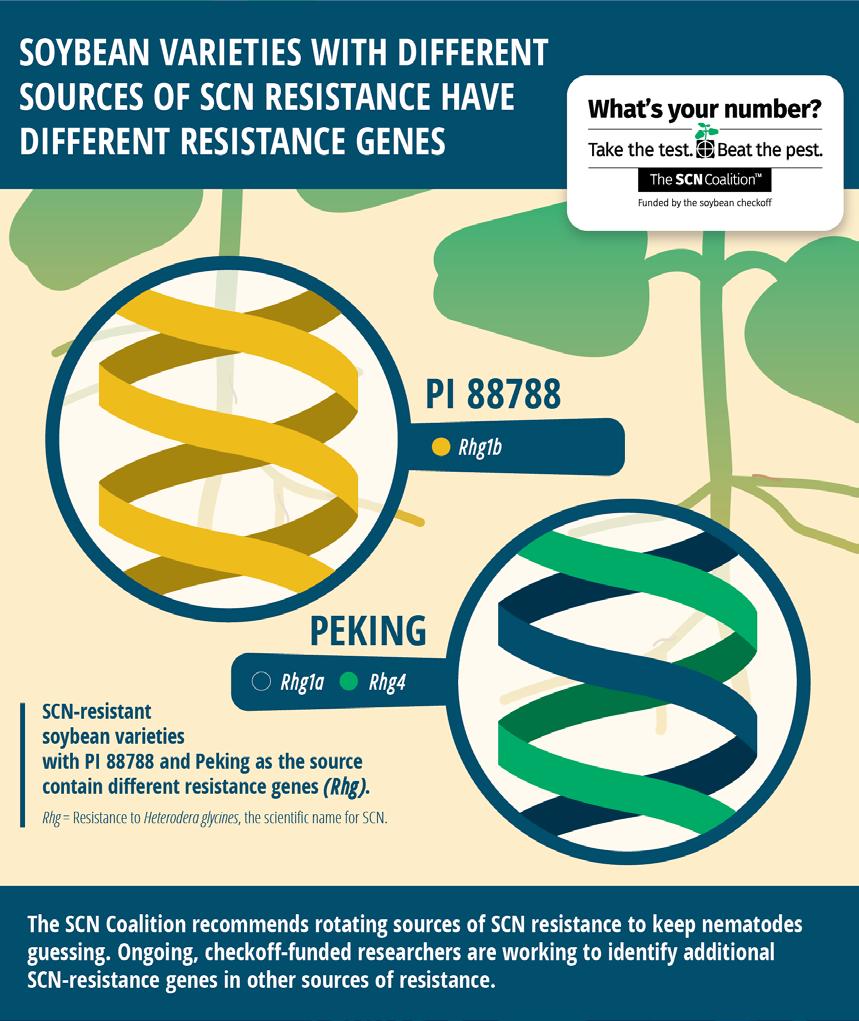
should not be relied upon as a standalone solution.
Crop rotation with non-host crops plays a significant role in SCN management. Rotating soybeans with non-host crops like corn and wheat significantly reduces SCN populations. The first year of non-host rotation is the most effective in lowering SCN numbers.
Enhancing soil health is another important consideration. Applying manure and incorporating non-host cover crops during non-soybean years can improve soil health and reduce SCN populations.
Nematode-protectant seed treatments can provide an additional layer of protection but
In conclusion, SCN management requires a multifaceted approach due to the presence of SCN resistance in Michigan. Avoiding back-toback planting of Peking-resistant soybeans is essential to prevent resistance breakdown. By utilizing soil testing, rotating resistant varieties, incorporating non-host crops, and maintaining soil health, farmers can sustain high yields while mitigating SCN’s impact.
As you plan to fit the right soybean variety in the right field this year, consider the source of resistance and place Peking varieties in fields that had a PI 88788 variety the last time that soybeans were grown there. It’s one more management practice to add but the results will be worth the effort.
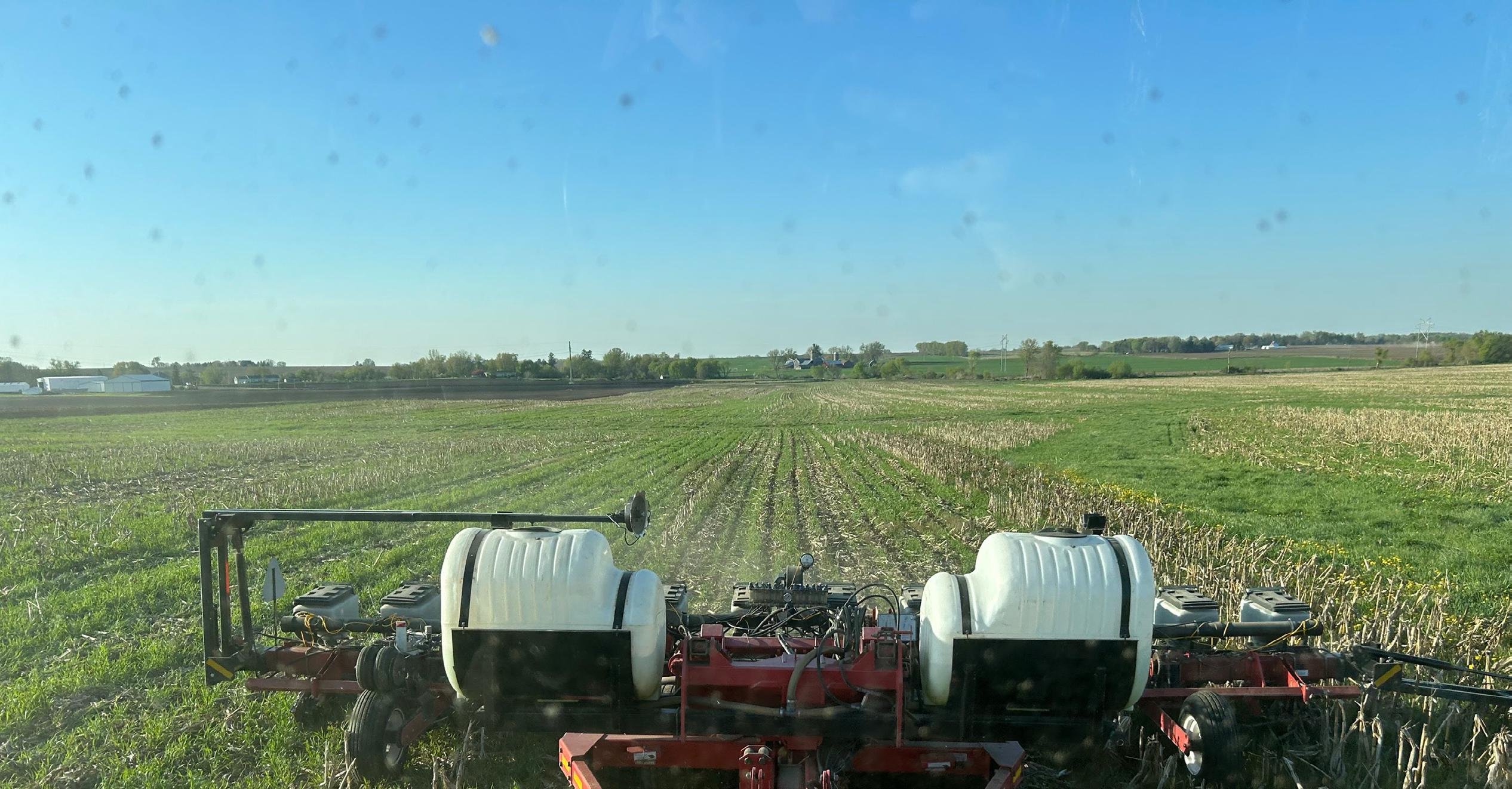
A farmer plants soybeans into a cereal rye cover crop in this SWOF enrolled field.
